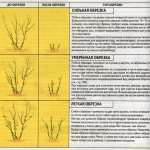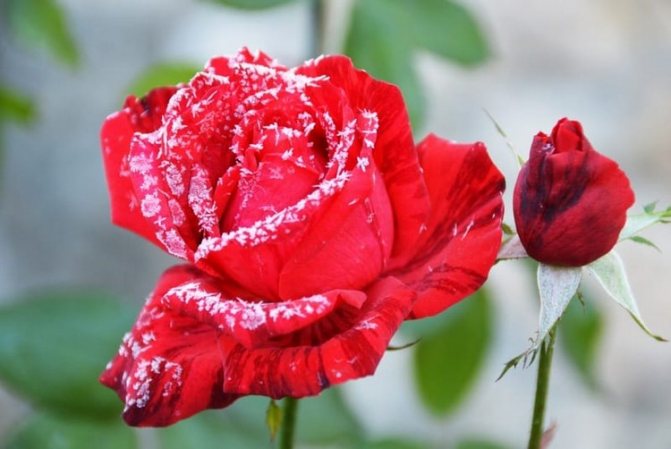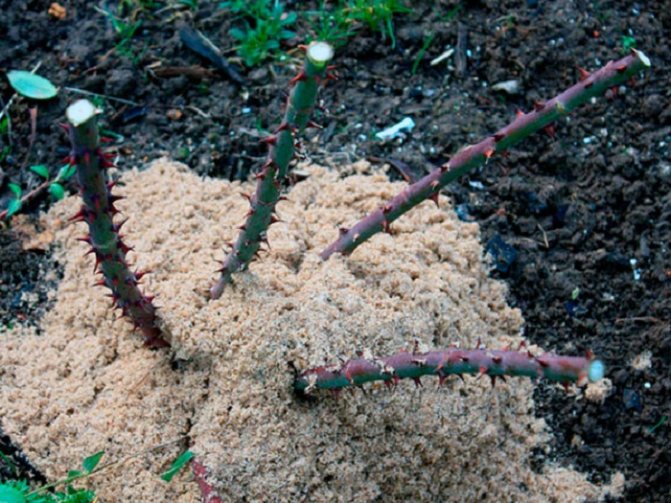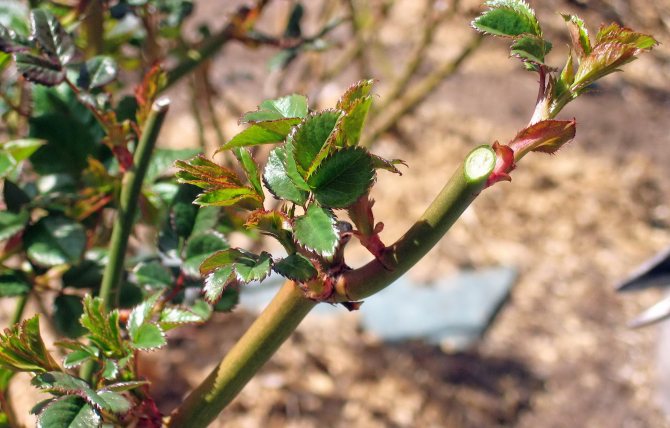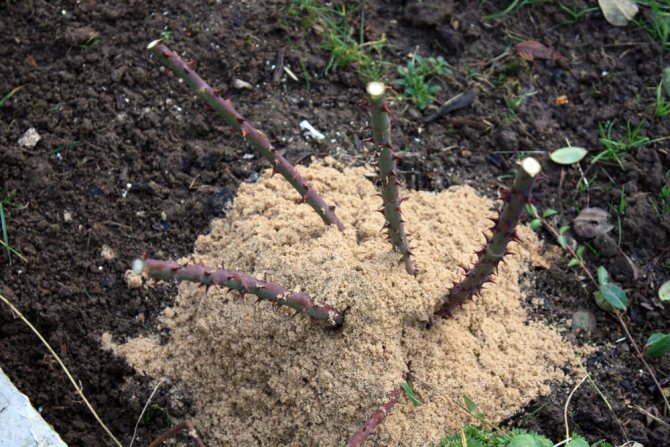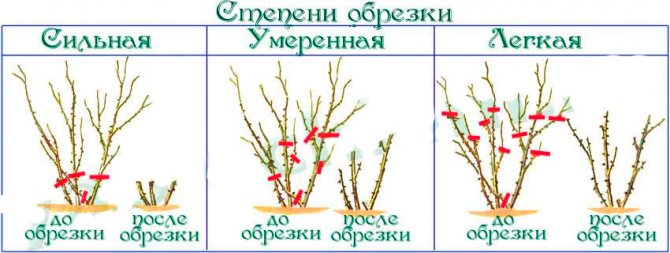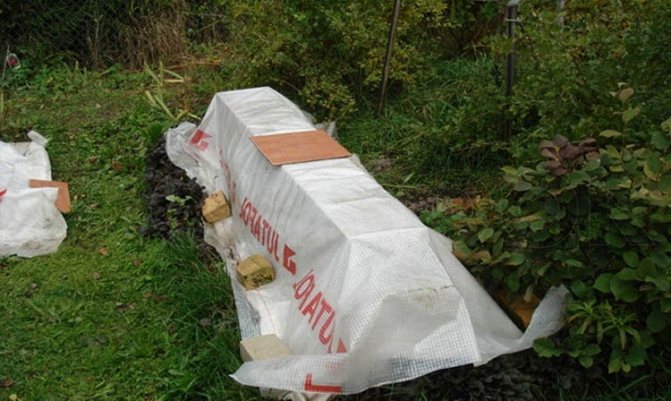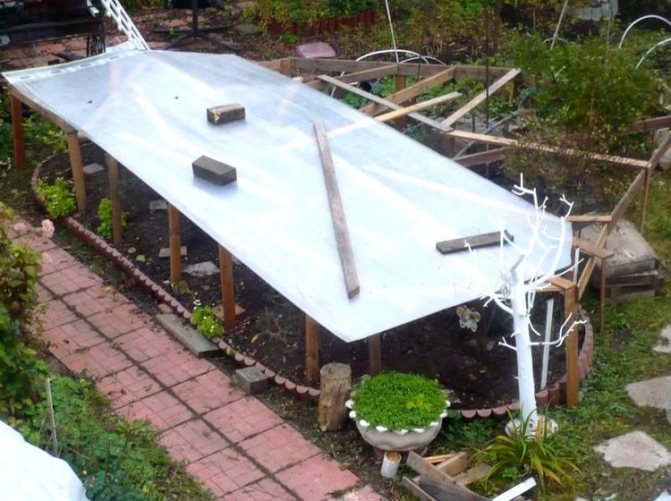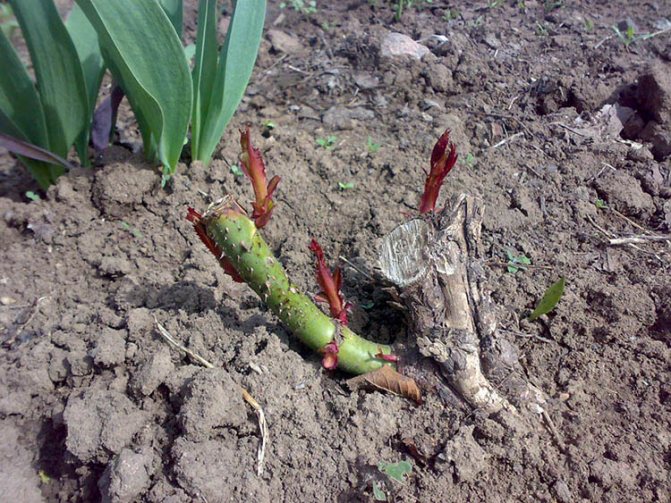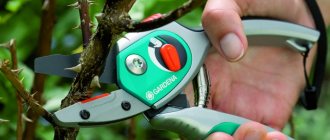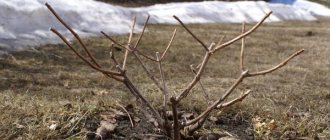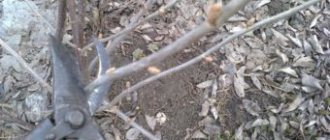Autumn trimming of rose bushes is a necessary operation to help the plant through the winter safely. Refusal from this procedure can lead to weakening and disease of the flower due to excessive thickening of the crown. This article describes the basic rules and methods for pruning roses in the fall for beginners for the winter. The approximate timing of the procedure in different climatic zones of our country is given.
Removing excess and weak branches of the rose will allow the plant to retain strength for active growth and flowering for the next year.
The need for pruning, its meaning
Many novice gardeners do not understand what pruning is for, when the plant is still completely insulated for the winter. Let's try to explain. With the onset of frost, the rose goes into sleep mode. The movement of sap in her tissues stops. The thaw triggers the awakening of the plant, which is immediately ready for growing again. Liquid nutrients begin to move inside the stems. When the temperature drops, the liquid freezes, tearing the tissues of the plant. Cracks are formed through which viruses, bacteria, roses penetrate, they can get sick and die.
To increase the frost resistance of the plant, the correct development of shoots and to eliminate the risk of fungal diseases, pruning is carried out. It increases the access of light, helps to rejuvenate the plant, and promotes abundant flowering. But different varieties of roses require different pruning, this must be taken into account when carrying out the procedure.
Autumn pruning dates
If experienced gardeners do not have the question of when to prune grew, then for beginners this is one of the main problems. Indeed, it is rather difficult to feel when the time has come for the procedure, because the time of its carrying out depends only on the weather. Although, for orientation, you can specify approximate dates:
- In the middle lane and the Moscow region - late October or early November.
- In the south of the country - in mid-November.
- In the Urals - in early or mid-October.
- In Siberia - in late September or early October.
In any case, you need to focus on the weather. Pruning is done when the average temperature outside the window becomes -3 ... -2 o C. Therefore, despite the fact that in the Moscow region roses are usually cut at the end of October, gardeners have recently begun to shorten the bushes at the end of November. Indeed, in the past few years, early winter has been very mild and warm.
Timing of pruning
Ornamental plants require proper care. A garden beauty requires a special approach, because a rose is a capricious plant. It is necessary to prepare it for wintering correctly, otherwise in the spring, instead of a varietal rose, you can see an unkempt rosehip bush on your site. And most importantly, pruning. At the first frost, when the temperature does not rise above -1 degrees at night, you should start pruning. For an important procedure, you need to choose a sunny day and prepare:
- Sharpened secateurs.
- Garden saw.
- Garden var or paint based on natural drying oil.
- Gloves.
Do not prune before the first frost. By pruning the shoots, we push the plant to form new shoots. Thaws will only contribute to this, and frost will destroy the entire plant. The autumn pruning process should take place when the plant is asleep.
Why do roses need pruning
Of course, you can let nature form the bush itself, but then we are unlikely to be satisfied with the result. After all, autumn pruning has many advantages. Among them:
- Disease prevention... Roses often get sick and are affected by pests, and the older the shoots, the more harmful microorganisms live on them. To prevent them from infecting young branches, they must be removed and destroyed.
- Rejuvenating and prolonging the life of the bush... All living organisms have a lifespan, and plants are no exception. Over time, the shrub degenerates, loses its attractiveness, withers and dies. Pruning annually in the fall helps to give the rose a youthful appearance and prolong its life by several years.
- Stimulation of the growth of new shoots... After pruning, dormant buds wake up, which would not wake up if the old lashes were preserved. Young branches are very powerful, they bloom luxuriantly and profusely.
- Stimulates the formation of large buds... Regardless of the number of shoots, the bush has a certain volume of the root system. And it is better to feed few lashes, but with good quality, than to scatter forces on a whole bunch of shoots that you will never be able to grow strong. Large flowers grow on powerful shoots, and small flowers grow on frail ones.
What shoots to cut
First of all, young shoots should be cut, they are least prepared for winter. If such shoots freeze, they cannot be reanimated. With the onset of spring, the shoots will begin to rot, bacteria and fungi will develop in them. This will lead to the death of the entire bush.
Experienced gardeners stop feeding plants with nitrogen fertilizers at the beginning of August. Top dressing with potash fertilizers from August to September promotes self-preparation of the plant for winter, the early ripening of young shoots.
Types of rose pruning
Pruning roses is quite a delicate matter, but at the same time not as difficult as many think. Depending on the length of the cut shoots, it is divided into short, medium and long.
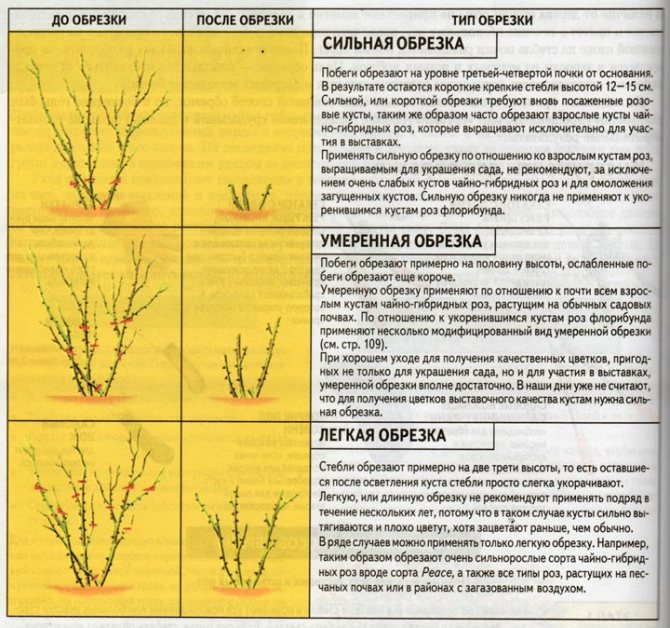
Light, strong and moderate pruning clearly
A short (strong) lash is considered to be pruning up to 2–4 buds from its base. Usually this type is carried out in the spring, but it is also able to rejuvenate the bush or even save it when there is no other way out (this happens with hybrid tea roses).
Medium (moderate) - up to 5-7 buds from the base of the lash. Helps roses bloom earlier than usual and increases their decorative effect.
Long (weak) - easy shortening of shoots. It is used mainly in summer to remove faded buds, but for some roses - certain varieties of scrubs and ground cover - this is the main type of pruning used for several years until the time for serious rejuvenation of the bushes comes.
Experienced gardeners use combination pruning - a combination of different types of pruning - to achieve continuous flowering in roses, particularly floribunda.
Types of pruning rose bushes
There are three types of pruning rose bushes, each of which is applicable to certain types and varieties of roses.
- Short cut. This is the most radical degree of pruning and is used in extreme cases. The bush is cut to the base, leaving only two buds.
- Medium pruning. The most effective, it is carried out at a height of 35 cm. 5 kidneys are left.
- Long cut. This is the most insignificant species; up to 10 buds are left on the shoot. Only flowers are cut.
Having chosen the trimming option, you need to know that the cut needs to be done on the external kidney, stepping a centimeter up from it. This is necessary so that in the future the bush is well ventilated and receives a sufficient amount of light. A sharp cut allows the water to drain off. We suggest that you familiarize yourself with the presented pruning scheme, they will help you clearly understand how it is carried out.
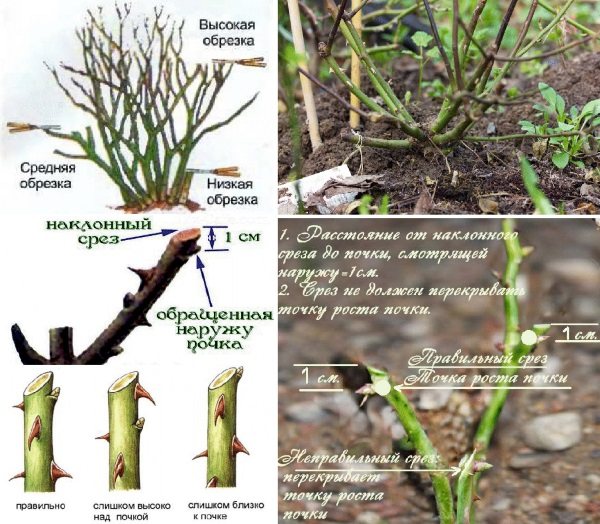

Basic rules for pruning
Even if you are not going to drastically prune the rose in the fall when growing it in the open field, pruning before wintering is mandatory. Here's how to do it right:
- Cut the shoots at a 45-degree angle, 5-10 mm above the bud. The picture below illustrates correct and incorrect slices.
- Remove faded flowers. The picture below shows how to do this correctly.
- Cut off all old (4-5 year old shoots), as well as damaged and diseased lashes.
- Remove fattening shoots, as well as those that do not grow outward, but inside the bush.
- Cut off all the unripe branches, as they will not be able to survive the winter anyway, but they will become an "excellent" source of infections.
By adhering to these rules, you will help the rose gain strength and stay healthy. A powerful and healthy bush is the key to lush and abundant flowering.
Pruning different varieties of roses
Each variety of roses requires a different approach. You need to know which method is suitable for a particular rose variety. Let's consider in more detail so that it would be easier for novice rose growers to decide when carrying out preparatory work in the fall.
Hybrid tea varieties
Medium pruning is recommended for this variety. If the climate is harsh enough, for example, in the Urals, you can shorten the shoots more so that it is easier to cover them. These roses are distinguished by their exuberant growth, do not be afraid to cut off excess. A short cut will even benefit this strain.
In Crimea, additional insulation is not used for such roses, because the climate allows them to survive anyway. In the suburbs, it is necessary to carry out a short pruning and slightly close the bushes.
Park varieties
These varieties do not require global pruning. In autumn, it is necessary to cut off the formed fruits and faded flowers, young shoots that have not yet become stiff. If the bush is too large, you need to thin it out by cutting off small branches.
Climbing varieties
Pruning a climbing rose in the fall is also minimal. Fruits and flowers are cut. But this variety requires careful shelter for the winter. It is necessary to carefully remove the lashes from the supports, bend them to the ground, twist them into small bunches, and fix them. You cannot put them on bare ground, you will need to prepare more spruce branches, you can spread it out in a thick layer, and lay a roll of roses on top. The top is covered with fir branches, they will hold back the snow, which is a real salvation from winter frosts. This shelter can be used to protect roses in the harshest weather.
Ground cover roses
Groundcover, or creeping rose varieties, like curly ones, do not need strong pruning. But they need to be insulated no less than climbing ones.
English varieties
It is necessary to cut roses for the winter in the Moscow region, selecting all the shoots that have not had time to ripen. To thin out the bush, cut off all the small twigs. You can also cut 2-3 year old shoots. It is believed that each ring should hold up to 8 shoots.
Stamp roses
Traditionally, pruning of young shoots is carried out. The rest of the pruning depends on the grafted variety. It is better to pay attention not to this, but to the careful covering of these bushes. The shelter should reliably protect the bushes from the piercing winter wind.
All cuts must be treated with wood ash or garden varnish. This is not easy to do, especially if the pruning of the shoots was carried out on climbing roses. After pruning, rose bushes of any kind must be treated with a solution of iron or copper sulfate, potassium permanganate or Bordeaux liquid. Do not cover the roses right away if the weather is warm. The plant can vanish, being in a closed insulated space.
Shoots that were cut in the fall do not have to be thrown away. If they are of good quality, without damage, obtained from uninfected plants, you can use them as seedlings to expand the rose garden. To do this, you need to read our article on how to save cuttings for future planting.
Features for different species
Of course, different types of roses have their own characteristics. Some require moderate pruning, others combined, and some require pruning only in spring or summer.
Hybrid tea roses, floribunda, as well as polyanthus, climbing (climbing) and semi-climbing roses must be shortened by half. As for tea and standard roses, it will be problematic to cover them for the winter without pruning, therefore, with the onset of stable frosts, they are pruned at a height of 45-50 cm from ground level. Unripe and soft shoots must be cut and the leaves removed, as they can serve as a source of infection. These roses are hilled in September, and immediately after pruning, additional hilling is carried out to a depth of 20-25 cm.
Polyanthus and miniature roses do not require heavy pruning: you just need to remove the inflorescences just below the place of their branching. After that, they should also be spudded.
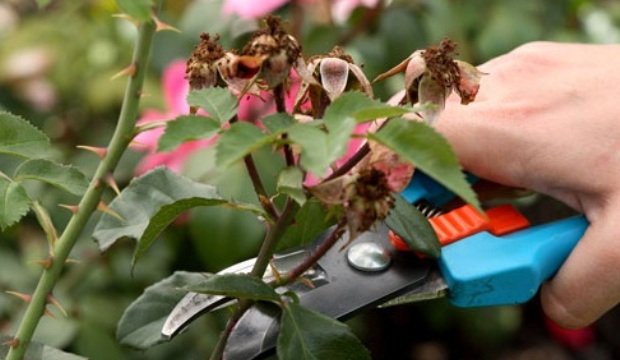

The pruning of the inflorescence is carried out just below the place of its branching
Shoots of climbing roses are removed from the arch and laid on the ground. They can be rolled up in a ring, or they can be laid out in full length. After that, the base of the bush is earthed up and fir branches are underlain.
Large-flowered climbing roses do not need pruning. Their lashes are untied from the supports and bent as close to the ground as possible, after which they are fixed with metal arcs so that they do not straighten.
Semi-twisted roses or shrubs only get rid of soft and immature shoots. The bushes huddle up, and if there is little soil under them, compost is added.
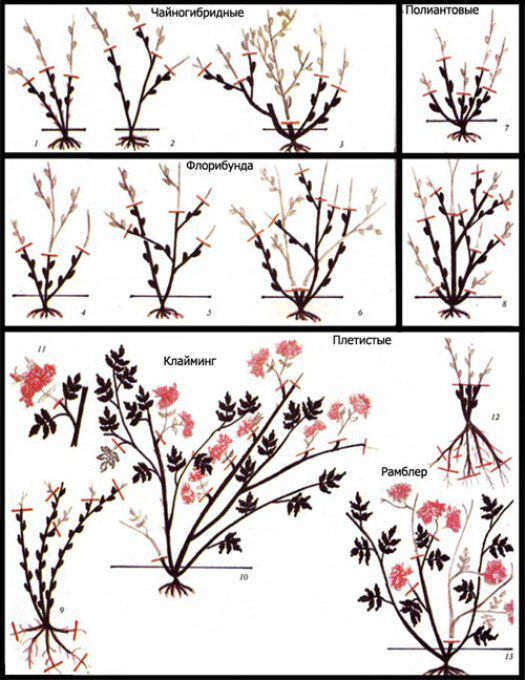

Scheme for pruning floribunda, climbing, hybrid tea and other types of roses
October works in the rose garden
In addition to pruning in the fall, gardeners have a lot to do. It is necessary to protect the rose garden from possible infection, dry it, prepare the rose bushes for shelter, and with the onset of cold weather, carefully insulate them.
To protect the shoots from infection, the trunks are treated with garden paint or water-based copper oxychloride. This should be done at the bottom to the level of hilling (30 centimeters). If the shoots are damaged, they are also covered with a layer of paint. After the paint has dried, it is necessary to carry out a slight hilling.
The rose garden should not be allowed to be damp. Excessive moisture will not allow the capricious beauty to winter comfortably. If the autumn is damp, you need to arrange the drying of the bushes. High arcs should be installed above them, such as are used to form greenhouses. The film is stretched over them. The bushes are slightly bent down and placed in such houses.
In order to prevent diseases, it is necessary to spray. Despite the cold weather, pests and diseases continue to multiply and can harm a weakened plant. Leaves and twigs should be sprayed with a 1% solution of Bordeaux liquid.
On the site, in particular, under the rose bushes, there should be no fallen leaves and other plant debris. The compost pit should be located away from the rose garden. If it is, and it is well fenced off, rubbish can be dumped there. If there is no such pit, all plant debris is burned, this will prevent the spread of the disease, if there are infected shoots, it will not allow the larvae of insect pests to multiply.
Read also Butterflies for cutting colored paper patterns
How to properly cover roses? Competent warming of roses in the fall is a guarantee that next year they will again please with abundant flowering. It is necessary to take this with all responsibility, since this is the only way to save the beautiful roses. The wrong or frivolous approach can cause the death of the plant.
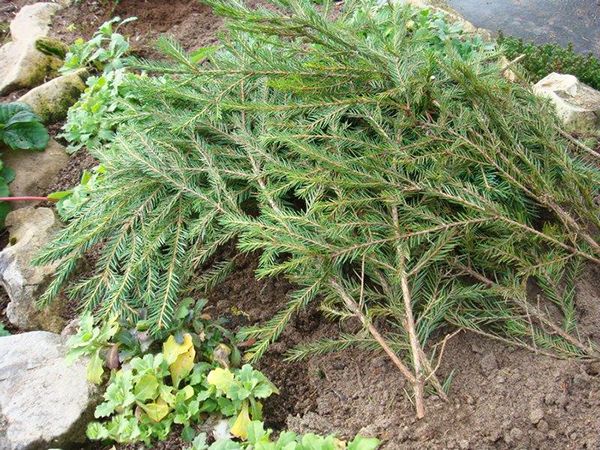

Why do you need autumn pruning and is it worth touching plants before winter?
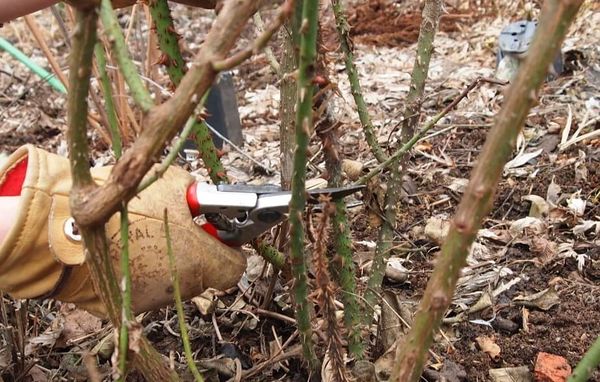

The main task of the autumn shearing of rose bushes is to give the plant a compact size so that it is easier to warm the bush for the winter.In most regions of our country, the rose garden is insulated for the winter with improvised materials: sawdust, peat, fallen leaves, agricultural fabric.
A small plant is more convenient to fall asleep "headlong" than a large bush, thereby reliably protecting it from frost.
Sanitary autumn haircut of roses consists in removing faded buds, weak and diseased branches, on which pathogens and pests can persist. In combination with the subsequent treatment of the bush with solutions of special preparations for diseases (Bordeaux mixture), the plant will leave completely protected during the dormant period.
Adjusting the number of branches in the rosebush will make it easier for the roots to supply the plant with nutrients. As a result, next year's flower buds will be large and vibrant. It is recommended to leave no more than 7 shoots on one rose bush.
Together with pruning, they remove all the foliage fallen from the bushes and other plant debris in the rose garden, depriving the insects - pests of the winter shelter.
After pruning, it is recommended to treat the rosary with antifungal drugs (fungicides):
- Abiga-Peak 50 g per 10 l of water,
- iron vitriol 300 g per 10 l
- or Bordeaux mixture.
The solutions are not only plentifully sprayed on the bushes, but also watered the soil under the plants.
Rejuvenating pruning is carried out in the fall, cutting off all branches older than 3 years of age. Older shoots grow more slowly and form flower buds poorly.
Stages of warming roses for the winter
Cleaning of all leaves. It is necessary to cut off all the leaves from the shoots. Although some gardeners believe that this is not necessary. But scientists have proven that the absence of leaves is a guarantee that fungal diseases will not infect the plant.
Digging the soil. You should work very carefully so as not to damage the roots. It is better to use a pitchfork instead of a shovel for this operation. With very long shoots, you should dig a bush on one side, then it will lie down.
Hilling. Hilling bushes is carried out on a sunny day to keep the soil dry. To create a mound, you can take crushed dry peat or sand. Dry loose earth is also suitable. The insulation height must be at least 15 centimeters. Floribunda rose and hybrid tea varieties are completely covered with earth. Such insulation will reliably protect the kidneys from severe frosts.
An important point: it should be remembered that untimely, like too early shelter of roses, can play a bad joke, destroying the plant. It is necessary to be guided by the weather conditions. It is good if you manage to keep the plants at a slight minus temperature of -3 ... -5 degrees. This will allow the plant to harden, naturally go into hibernation, stopping the growing season. If the temperature stays within 8-10 degrees for several days, it's time to cover the bushes. Roses grafted onto the rosehip root can withstand lower temperatures when grown in the Moscow region. But the self-rooted roses of some thermophilic varieties can die already with the first frost. It is necessary to cover the climbing plants by mid-October.
The best materials for sheltering roses are: foliage, spruce branches of conifers, burlap, cardboard, agrofibre. Capital shelters are made of boards, wooden slats, metal arcs. Covering material is pulled and fixed on them, preventing it from rising. It is necessary to fix everything to the ground, sprinkling with soil or stones. You need to make sure that the structure does not collapse on the bushes in winter under strong gusts of wind or a layer of snow.
Using these simple rules for preparing a shrub for winter, it will be possible to carry out all the work without any particular difficulties. High-quality preparation of roses for the winter season is the key to good growth, development and rapid flowering during the next growing season.As you have noticed, the rose grower has a lot to do in the fall, but they are worth enjoying the most beautiful double flowers of Her Majesty Rose all summer and autumn.
Modern varieties of roses bloom for a long time. And this is undoubtedly a plus. However, the plants are unprepared for winter. Their shoots and leaves turn green, flowers bloom. It is important not only to organize the wintering of plants, but also to properly prepare roses for winter, especially in the Moscow region, where frosts are interspersed with thaws.


With the onset of subzero temperatures, sap flow in plant tissues ceases, roses go into hibernation. However, when a thaw sets in in the Moscow region, the plants are again ready for the growing season, nutrients in dissolved form begin to move in them again, which freeze as the temperature drops below 0 ° C, tearing the plant tissues. Bacteria and viruses penetrate through wounds, roses get sick and can die.
Types of covering material for roses
Nowadays, special shelter materials are sold. They help maintain the temperature and do not collect condensation, which has a detrimental effect on roses during the winter thaw. Many gardeners are already using: geotextile, spunbond and lutrasil.


Shelter Spunbond
IMPORTANT ADVICE! (click to find out)
IMPORTANT ADVICE! It is not recommended to use polyethylene for covering roses. Condensation collects underneath.


The most popular is spunbond. Its price depends on the density.
| Density. g / m | Width. m | Length, m | Price per roll, rub. | Price per running meter, rub. |
| 15 | З.2 | 500 | 4150 | 8.30 |
| 25 | 3.2 | 300 | 3552 | 11.84 |
| 30 | 3.2 | 300 | 4262 | 14.20 |
| 35 | 3.2 | 250 | 4145 | 16.58 |
| 40 | 3.2 | 200 | 3788 | 18.94 |
| 50 | 3.2 | 150 | 3552 | 23.68 |
| 60 | 3.2 | 150 | 4262 | 28.41 |
There are three types of shelters: dry air, shield and jute bags.
Dry air shelter
The structure of the shelter is made in the form of a cone. First, a frame is formed from metal rods, the height of which is about 60 centimeters.
From above, the frame is covered with insulation, which keeps the temperature well. Lutrasil, cardboard and spruce branches are used.
The next step is to fix the moisture-proof layer with a wire, apply a film or a special non-woven material. The lower part of the structure is covered with earth and bricks.


Cone Shelter
Shield shelter
They are used mainly for curling varieties. For this, the branches of roses are bent to the ground and laid on the prepared spruce branches. Further, additional fixation is carried out with a wire, driving its ends into the ground.


Bending down a curly rose
Then, at the same distance, pairwise connected tubes or rods are installed. A covering is attached on top: wooden shields or fiberglass. The side walls are deepened into the ground. The cover is lowered tightly to the ground and also sprinkled with soil.
In such a shelter, a constant temperature is kept, at which the threat of frost is not terrible.


Shield shelter
Jute bags
This is the most economical option and the easiest preparation for insulation. The plant is covered with a bag on top. The bottom in the bag is cut and filled with branches of conifers. Then they give the appearance of a cone and tie it in a spiral with a rope. In severe frosts, for additional protection, an additional cover is made from above with a film.


Shelter with spruce branches
NOTE! (click to find out)
NOTE! The most effective, albeit the most expensive, is an air-dry type of shelter.
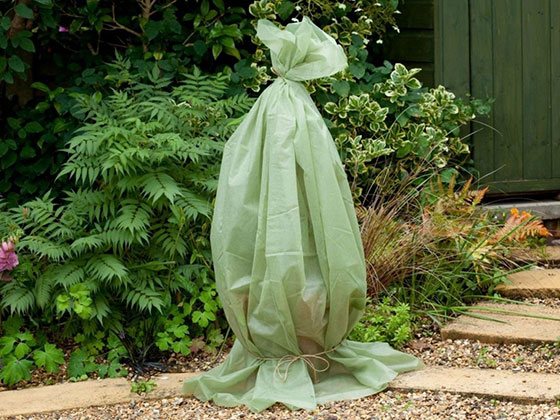



Shelter in winter
Preparing roses for winter in the suburbs
Preparation of roses for winter in the Moscow region begins in the summer. They change the qualitative composition of fertilizers, stop adding nitrogen, which contributes to the growth of shoots and foliage, and increase the amount of potassium and phosphorus in top dressing. So roses will strengthen the root system, and those shoots that have managed to grow back will be able to ripen. Options for feeding roses in preparation for winter in the Moscow region:
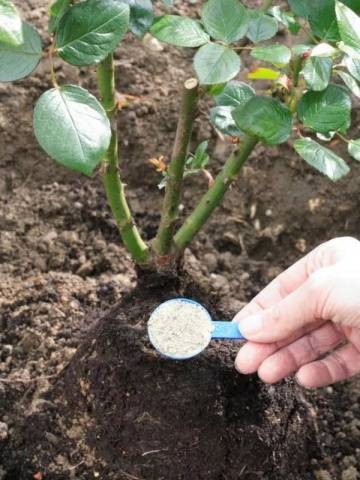

- In mid-August, potassium monophosphate and potassium superphosphate (15 g each) are added, dissolving in 10 liters of water. If it is rainy autumn, then it is better to apply fertilizers in granular form under the plants. After a month, feeding is repeated;
- 1 tbsp. l. calcium nitrate diluted in 10 liters of water;
- A valuable nutritious fertilizer rich in potassium - banana skins. They are brought under a bush, embedded in the soil, pre-chopped. Or brew like tea, if dry banana skins are available;
- Wood ash - 1 tbsp. scattered in the near-trunk circle of roses in a dry form, if there are frequent rains, when it is dry autumn, then it is better to prepare an ash solution (1 tbsp. wood ash / 5 l of water).
Top dressing of rose bushes in the Moscow region with a predominance of phosphorus and potassium is carried out twice, with a break of a month. Roses take foliar dressing very well, then the nutrients are absorbed in full. A solution for foliar spraying of roses is prepared by reducing the dose by 3 times.
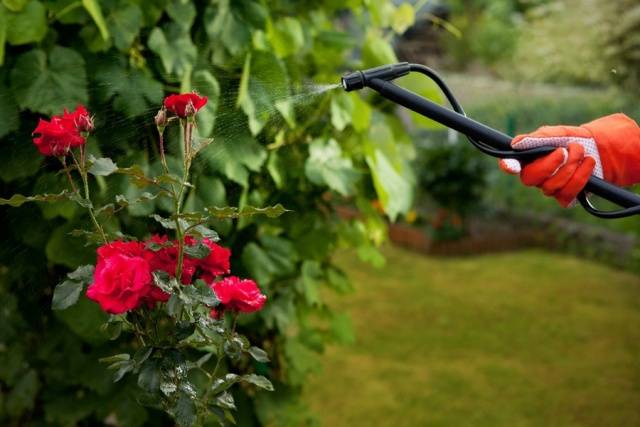

With the onset of autumn, in the Moscow region, they cease to loosen the soil around the roses. This is done so as not to cause the growth of new shoots from the replacement buds and new thin roots. In the third decade of September, the growing point is pinched off the shoots of roses, small buds are removed, and those that have faded are allowed to ripen.
Another important agricultural technique is the autumn pruning of roses. It makes it possible not only to facilitate the sheltering of roses in the Moscow region for the winter, but also to sanitize the rose bush, its formation, to lay the foundation for future shoot formation, and, consequently, flowering.
Pruning of plants in the Moscow region is carried out in the fall, shortly before the roses are sheltered for the winter. Roughly late October - early November. It is worth making an allowance for the peculiarities of the climate in the regions of the Moscow region. There are no exact dates for pruning, you should wait until a constant small minus to -5 ° С is established.
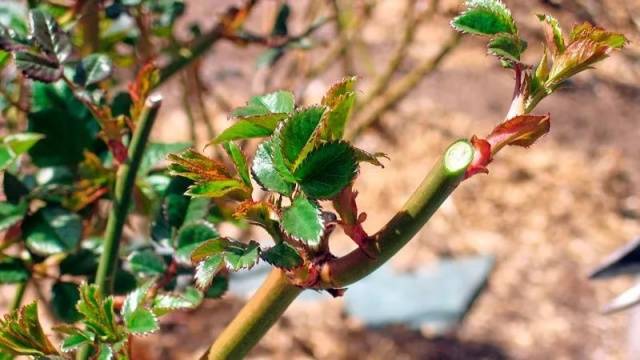

In the fall, cut off damaged leaves and shoots, broken, deformed, with signs of disease. Also remove the flowers of the plant, dried and still flowering, unripe shoots. A sign of the maturity of a rose shoot is a light core. Several test cuts can be made to ensure that the shoot is mature.
The question of removing foliage is controversial, many gardeners will not remove foliage, since this is a rather large amount of work when there are more than a dozen rose bushes in stock. They conclude, based on many years of experience, that nothing bad happened with roses over the winter. Another opinion is that foliage should still be removed, as it can cause decay of the bush.
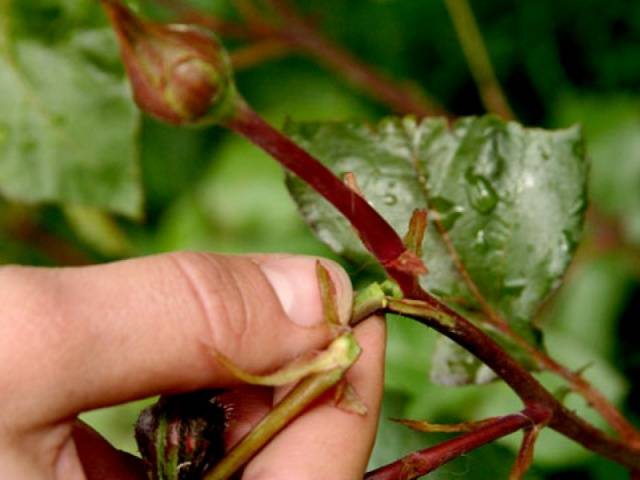

Young, freshly planted plants and bushes that have been growing for many years are pruned. Gardening tools: The hacksaw and pruning shears must be sharp and treated with an antiseptic. Prune roses in good clear weather. The type of pruning depends on the type of roses:
- Short pruning - 2-3 buds remain on the shoot;
- Average pruning - 5-7 buds;
- Long pruning - 8-10 buds.
After pruning, all plant residues must be removed from under the bush, and even better burned, especially if there were signs of disease in the rose bushes.
Cut rose bushes are treated with a solution of copper sulfate, iron sulfate, Bordeaux liquid or potassium permanganate. If the weather is warm, then the plant continues growing, even in the absence of leaves. Therefore, do not cover roses too early, in a confined space the plant may die, dry out.
Untimely shelter can cost the life of plants, the question of when to shelter roses for the winter in the Moscow region is extremely important. Focus on the weather conditions in the region. Well, if it is possible to withstand rose bushes at a temperature of -3 ° C, the plants will finally stop vegetative processes and go into a state of hibernation. At a temperature of -7 ° C-10 ° C, the roses should be covered. Roses grafted on the roots from rose hips can also withstand lower temperatures in the Moscow region, while self-rooted roses are afraid of the first frost and can die already at a temperature of -3 ° C.
Read also Catalog of varieties of royal pelargoniums with photos
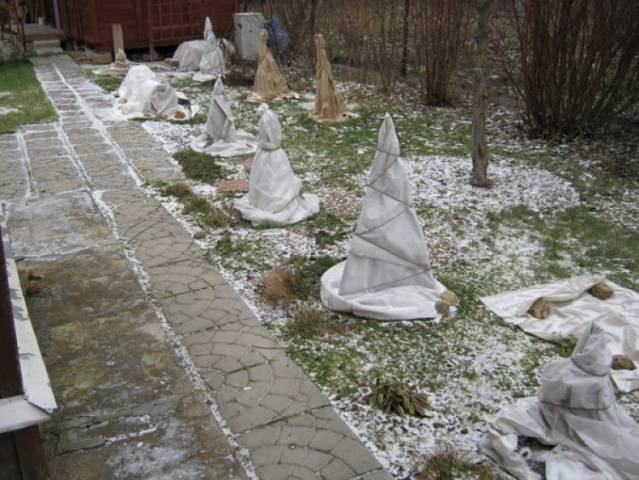

To hide roses in the Moscow region, spruce branches, foliage, cardboard, burlap, agrofibre and film are used. More complex shelters are made from arcs or boards, over which some covering material is pulled. All elements of the shelter for the winter are securely fastened so that they do not collapse under the thickness of snow and are not torn off by strong gusts of wind.
Watch a video on how to prepare roses for winter:
Pruning roses in the fall for beginners for the winter
Before starting work, you need to prepare the tool:
- garden pruner;
- garden saw for removing thick branches;
- var for covering up wounds from cuts.
The pruner and saw should be sharp to get a smooth cut. Wear thick gloves to protect your hands from thorns.
If a large number of rose bushes are being prepared for pruning, it is recommended to keep a solution of potassium permanganate or phytosporin ready. In the process of work, the pruning shear blade is dipped into the solution, starting to cut the next bush.
Disinfecting the instrument will help prevent the spread of infection, if any.
The branches must be cut at an angle of 45 degrees, at a distance of half a centimeter from the bud. It is necessary to take into account on which side of the branch the bud is under the cut, because it is from it that a new shoot will begin to grow in the spring. Avoid pruning a branch over a bud that looks inward or downward.
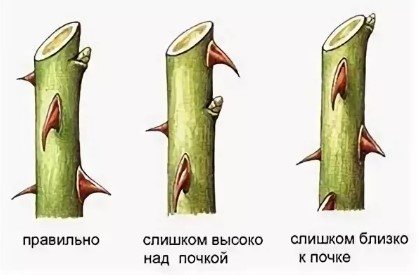

The cut with the pruner should be done in one sharp motion, without leaving tattered bark on the branches.
Now read:
- Pruning tree, paniculate and large-leaved ...
- When to prune peonies after flowering. When to prune for the winter
- Caring for various types of roses in the fall. Preparation…
- Hydrangea care in the fall. Preparing for winter
- Pruning roses in spring - video and diagrams
The wound on the shoot must be treated with garden varnish, wax or special glue. Moisture will get on an unprotected cut, germs and the branch will begin to rot.
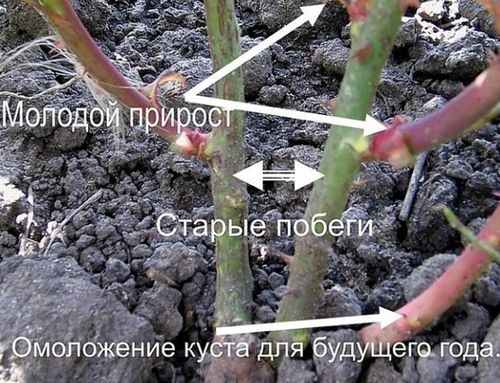

Sanitary pruning
The bush gets rid of weak, sick and damaged shoots. Extra branches are removed, leaving no more than 7 shoots on the plant. Make sure they are evenly spaced on the bush.
The florist needs to imagine how a bush covered with leaves will look in spring, and leave those shoots that will not shade the crown.
Anti-aging pruning
A short haircut, in which all branches are removed under the root, over 3 years old. If the bush has not been processed for a long time and all its shoots are old, they are shortened as much as possible, leaving 2-3 buds on the stumps.
Pruning roses before planting
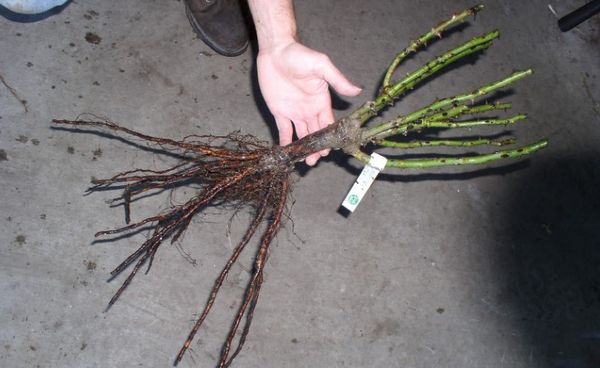

When planting rose seedlings in autumn, their shoots are cut as short as possible, leaving no more than 3 buds on a branch. This will help the plant adapt more easily to the new location.
If the rose has an open root system, it is recommended to cut its roots by 3-5 cm to stimulate the growth of lateral roots.
Pruning a young rosebush correctly
In the first year of planting a rose bush, it is pruned rather shortly for the winter. In addition to removing weak branches, strong shoots are shortened to 14 cm. This type of pruning allows a young plant to successfully overwinter, covered with a completely insulating material.
Short pruning is not applicable to park and ground cover varieties of roses.
After flowering
To preserve the strength of the plant, all wilted buds, together with a part of the stem of 8-10 cm, are removed from the bush. Unopened buds that have formed on the rose too late are also cut off.
Video tutorial on pruning roses in autumn
An expert from the Garden World channel will tell you about pruning roses in the fall for beginners.
Planting roses in the fall in the suburbs
Planting roses in the Moscow region can be carried out both in spring and autumn. The fall planting has even more advantages than the spring planting. In the Moscow region, there is more high-quality planting material in the fall. Young plants have time to get stronger, to build up the root mass, and in the spring, having increased the greenery, they will begin to bloom no worse than the old bushes.
In the Moscow region, it is better to plant roses at a temperature of + 13 ° С + 15 ° С.These temperatures occur in mid-September - mid-October. Before the onset of cold weather in the Moscow region, the seedlings have time to adapt, take root and successfully endure the winter period.
For planting, choose a well-drained area that will be well lit by the sun. The passage of air masses should be taken into account, roses do not like drafts.
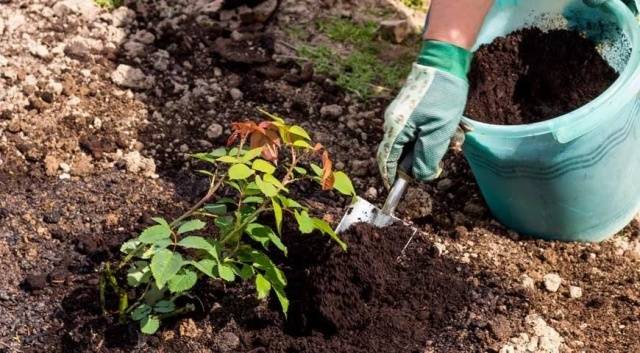

Plants prefer highly fertile and well-drained soils. If there are sandstones on the site, they should be diluted with clay, while a clay layer of 5 cm is laid on the bottom of the planting pit.If the soils are clay, then their composition is improved by adding gravel and river sand. A layer of broken brick or gravel for drainage is laid at the bottom of the pit.
Distance when growing roses: 0.7 m between bushes and at least 1.5 m between rows. A planting hole is dug in a large volume, it will have to contain food for the rose for several years in advance. The depth of the pit is not less than 0.5-0.7 m, the dimensions are 0.4x0.4 m. Peat, humus, compost are taken abundantly, mixed with the existing soil 1x1 and placed in the pit. It is better to prepare the soil for roses in 2-3 weeks so that the soil settles and does not have air voids.
Before planting the plants, the soil is loosened again and a mound is formed on which the root system is placed, carefully straightening all the roots. This is done if the seedling was purchased with an open root system. Before planting, you should shorten the roots to the size of the planting hole, at the same time checking them.
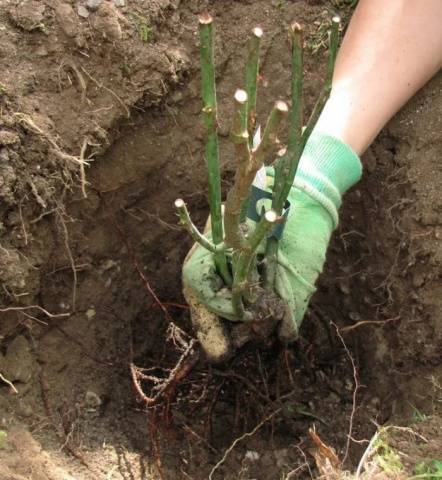

If your seedling was purchased in a container, then it is taken out together with an earthen lump and placed in a hole so that after falling asleep with an earthy mixture, the root collar is slightly deepened, by about 5 cm. The soil around the plant is thoroughly crushed. And watered abundantly.
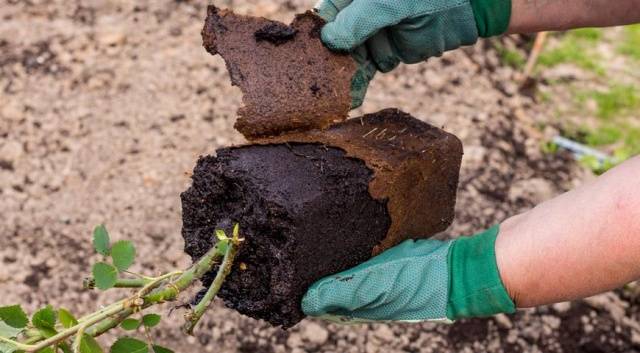

In order for a young rose to winter well in the Moscow region, it is necessary to cut the bushes with the onset of the first frosts in early October, removing the inflorescences, buds, dried shoots and unripe shoots, as well as all the foliage. Cover completely with soil, peat or compost.
Then organize a shelter, just like for adult roses in the Moscow region. Using arches or wooden shelters. Or install a support around the bush, on which to strengthen the cardboard or mesh, and fill the foliage or spruce branches inside. Plastic or wooden boxes can be used to protect the plants from the cold. Usually, this kind of shelter is enough to keep roses in the Moscow region in cold winters.


Preventive treatment of roses in the Moscow region
Even if the roses did not hurt in any way in the current season, they should be treated with a 2% solution of Bordeaux liquid or ferrous sulfate before covering. For the same purpose, drugs can be used. For example, "Skor", "Topaz", "Fundazol", "Hom", "Ridomil Gold". All funds are used strictly according to the instructions. If any of the drugs was used in the spring, it should be replaced with another. Biological fungicides are not suitable for use in the fall, as they work effectively only at temperatures above 15 ° C.
Do you need to prune roses in the fall?
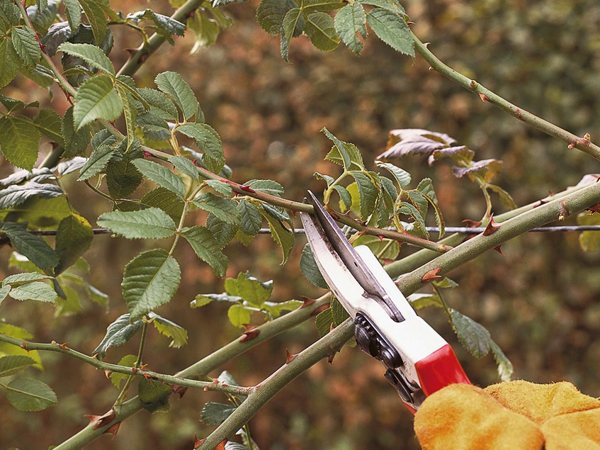

Regardless of when the roses were planted, in the fall the bush needs cleaning before sheltering for the winter. The plant undergoes rejuvenating pruning, unripe and diseased shoots are necessarily removed, thus, the flowers are prepared for winter, helping to accumulate and preserve nutrients for active growth in spring.
What are the benefits of pruning roses in autumn? Its advantages include:
- the accumulation of nutrients to plants that provide intensive growth in spring;
- enhanced development of the root system;
- providing protection against fungal and infectious diseases;
- cut bushes are easier to cover for the winter;
- laying more flower buds and new shoots.
Autumn pruning will have no drawbacks if it is carried out at the right time, without awakening dormant buds. For the procedure, you should choose a dry, clear day.If you do everything right, your favorite roses will bloom in the summer.
Shelter of standard roses in the Moscow region
It is not necessary to use a frame to hide standard roses. It is much easier and less time consuming. Rose bushes must be covered with fallen leaves or spruce branches. It must be covered with a film material or roofing material.
Attention! In the suburbs of Moscow, it is better not to use the frameless method, since pink shrubs, as a rule, begin to rot.
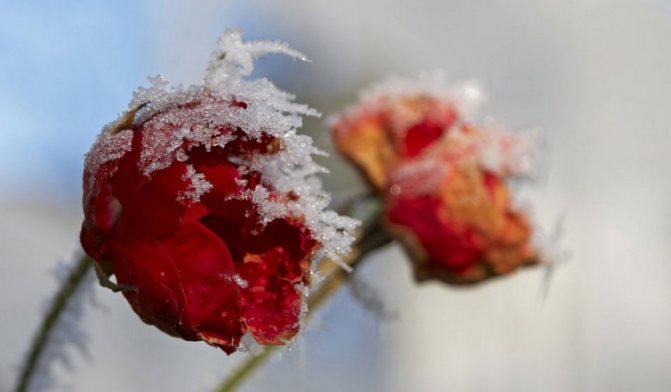

So, you have learned how to cover roses for the winter in the Moscow region with covering material, and now your plants will be able to winter without any damage.
loading ...
When is the best time to prune - in spring or autumn
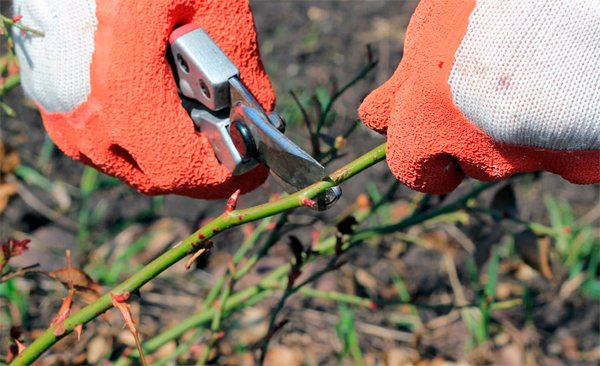

Not everyone knows which pruning for roses is more useful - spring or autumn. To put the question like that is not entirely correct. Shoots can be shortened in spring and autumn, but this event will have different goals. If corrective pruning is carried out in the fall, then in the spring it can be called the main one. The procedure should be started immediately after the snow melts. It is important to carry out the work before the start of the movement of juices.
The bush must be examined to determine which shoots are to be removed. Branches that have died during the winter are cut to the ground. A section of healthy tissue should appear on the cut, if the wood is black, it means that you need to do a cardinal pruning, removing all dead branches. Healthy stems only need to be shortened slightly.
Following this, shoots growing inward are removed. It is important to do this before the start of the growing season, otherwise the bush will then become too thick, the air exchange will deteriorate, which can provoke fungal diseases. Crooked and intertwined shoots also need to be removed, they still will not give a beautiful flowering. Shrub roses are given a wide, open shape with an empty middle.
Plants trimmed in this way will receive the maximum amount of sunlight and rain moisture. Freshly planted roses are also pruned in spring. In this case, no more than 4 buds are left on each shoot. Radical pruning is also used if the bush is almost completely frozen out, affected by pests, or requires rejuvenation.
Tips for a novice gardener
Novice gardeners often find themselves at a dead end, trying to answer the questions: "How to prune roses correctly?" and "How not to harm?" The following recommendations and advice will help you carry out the procedure correctly without harming the plants.
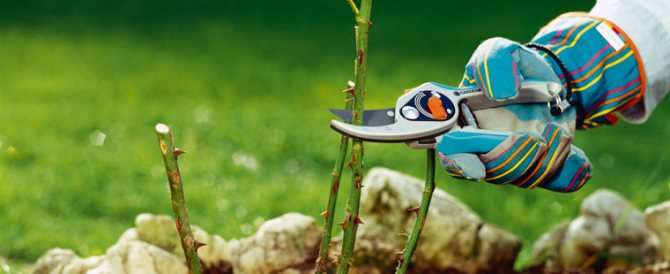

The trimming tool must be in good working order, sharp, clean and disinfected.
To begin with, choose a clear day without wind. To work, you will need a high-quality, serviceable pruner: it should not have any chipping or rust marks. Otherwise, when pruning the stem, the pruner will simply crush and split it, which will facilitate the infection's access to the inside of the plant.
Three-year-old shoots, in which the bark has matured, are carefully cut out with a hacksaw.
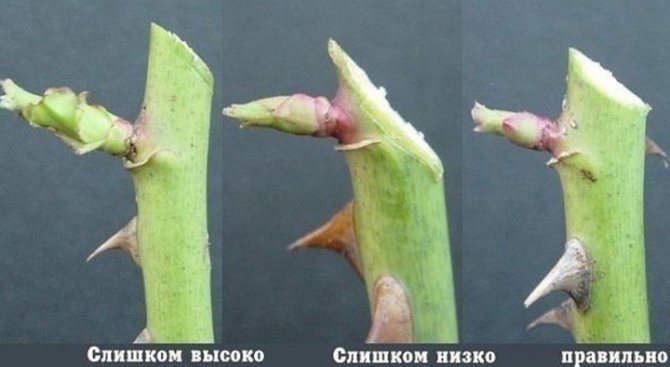

It is necessary to cut the shoots above the bud at an angle of 45 degrees.
Shoots should be cut over the bud facing outward to provide the bushes with maximum illumination and ventilation. Above it, a distance of 0.7 cm is left, the cut angle should be 45 degrees. It is impossible to cut too close to the kidney - there is a great risk that it will not open. If you retreat too much, then the escape will be weak and may not survive.
The correct cut allows water to drain away, preventing stagnation and therefore preventing the spread of infection.
After the end of pruning on cuts with a thickness of more than one centimeter, we use a garden pitch.
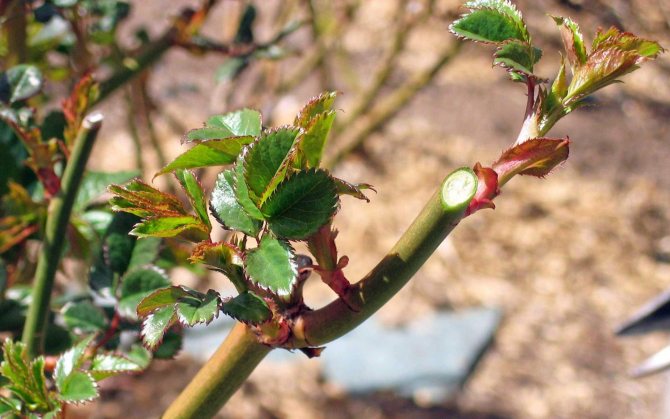

This is what a properly trimmed shoot should look like.
Before pruning, the pruner is disinfected with alcohol. This operation must be repeated regularly. The cut off shoots are burned or sent to the dung heap. There, all pathogens will die under the influence of high temperatures.
When to trim
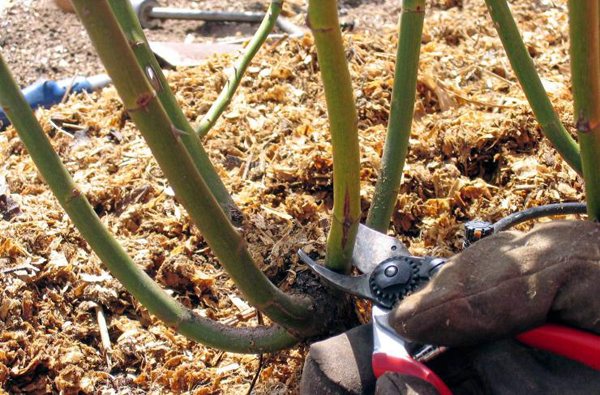

Autumn pruning of roses is carried out just before the shelter for the winter. This procedure should be carried out from the second decade of October to mid-November. The exact timing of the pruning of shoots depends on the weather and the specific region. As soon as night temperatures are below freezing for several days in a row, you can grab the pruner. By the way, the tool for pruning roses should be very sharp, experienced summer residents prefer a knife so as not to crush the wood fibers.
In the suburbs, the middle lane
At the very beginning of autumn, the soil around the roses in the Moscow region ceases to loosen, preparing the plants for a dormant period. Towards the end of September, you will need to pinch the tops of the shoots, and also remove the ripening buds. The main pruning should be done much later. Most often, it is carried out in early November, when at night the air temperature begins to drop to -5 degrees.
Some doubt whether it is necessary to leave leaves on the shoots or it is better to cut them off. If there are a dozen or more rose bushes on the site, such a procedure will be problematic and take a long time, so many leave foliage on the branches. In the event that you have a few roses, the leaves can be torn off, as they increase the risk of decay and diseases of the bush.
In the Urals, in Siberia
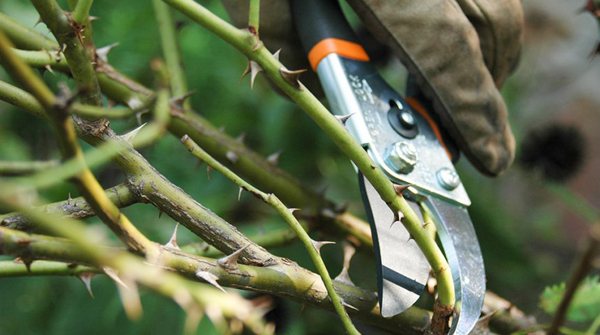

In the Urals and Siberia, spring comes late, and in winter there can be 40-degree frosts, so in these regions it is better to grow zoned varieties of roses. Preference should be given to planting varieties grafted on rose hips. Such plants have strong immunity, they freeze less often and get sick less.
Read also Do-it-yourself high jack
Canadian roses tolerate the Ural climate well. When pruning branches at the end of summer, you should not do too short pruning - this can provoke the growth of new shoots that do not have time to ripen before winter.
In the last days of summer, the upper leaves are cut off to prevent the development of fungal diseases, and the lower ones are left for photosynthesis. The second stage of the preparatory work is carried out in the first decade of October. The stems of roses are shortened to a height of 50 cm, only climbing varieties are not pruned. The bushes should be sheltered in the winter after the final onset of frost.
In the Leningrad region
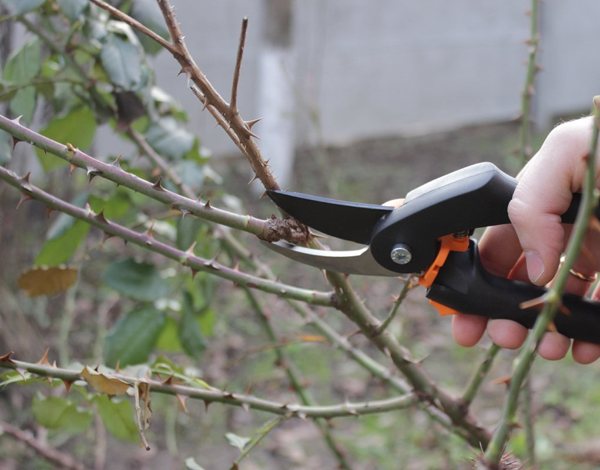

Autumn in Leningrad is usually windy and rainy. Choose a dry and clear day for pruning roses. You need to try to make the cuts smooth and even, then there is less chance of infection or moisture getting inside. Persistent subzero temperatures in this region come in mid-October - at this time, pruning should be done. Soon thereafter, the roses are covered with any breathable material.
Winter-hardy varieties of roses for the Moscow region
Varieties adapted for the Moscow region and northern regions:
- Amadeus;
- Gloria Day;
- Pierre de Ronsard;
- Flamingant;
- Gloria de Climing;
- Rimos;
- Tchaikovsky;
- Password;
- Ingrid Bergma;
- Super Dorothy.
Among them there are climbing and standard varieties, terry and classic. The color of the petals is snow-white, pink, yellow, red and burgundy. There are two-colored and changing shade depending on the flowering phase. Some emit a pronounced aroma, others almost do not smell, but captivate with touching tenderness and richness of color.
The varieties are adapted for the Central regions, take root well in the Moscow region, in the Urals, in the Leningrad region, do not require additional maintenance costs.
But preparation for winter is still necessary, despite the high frost resistance - it starts from the last days of August and continues systematically in the fall until the October frosts.
Often it is written on the packaging that the variety is winter-hardy. Inexperienced gardeners living in the Moscow region "peck" at him and do not cover the rose bushes for the winter. As a result, the flowers are irretrievably lost. After all, winter frosts and thaws destroy not only the buds, but also the root system.
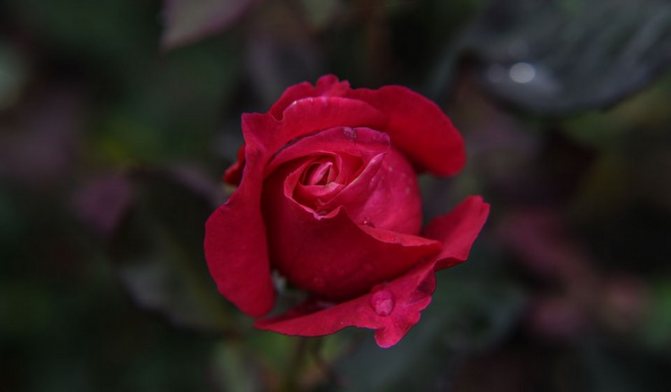

How to properly prune roses for beginners
Given the number of varietal varieties of roses, it is not surprising that a beginner can get confused when starting pruning. Indeed, each variety has its own rules for shortening shoots. One might ask: why do roses need pruning at all? Why not give nature the right to form this beautiful plant itself.
However, it happens that over the years, the tops of the shoots die off, and shoots, directed in different directions, begin to grow chaotically from the lower buds. The bush may become diseased and look messy and disheveled. It is permissible not to cut only specific roses, with representatives of varieties the situation is completely different.
Bush
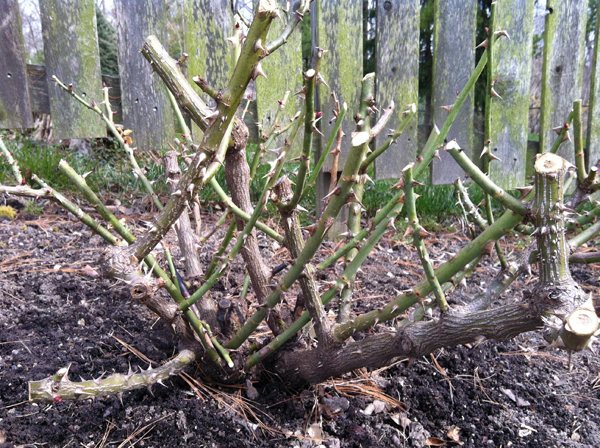

Due to the correct formation, some varieties of bush growth are able to bloom several times per season. In order for the plant to remain strong and healthy, it needs competent autumn pruning. If it is not carried out, the bush will weaken over the winter and will not give abundant flowering. First, dry and old shoots that are more than 3 years old are cut off at an angle of 45 degrees.
Then, soft, unripe branches are removed, which will still die during the winter. At the last stage, cut off the shoots directed inside the bush, unopened buds, flowers and leaves. The cut must be done, retreating from the outer bud by 1 cm. The pruning rules are the same for both adults and young spray roses.
Tea-hybrid
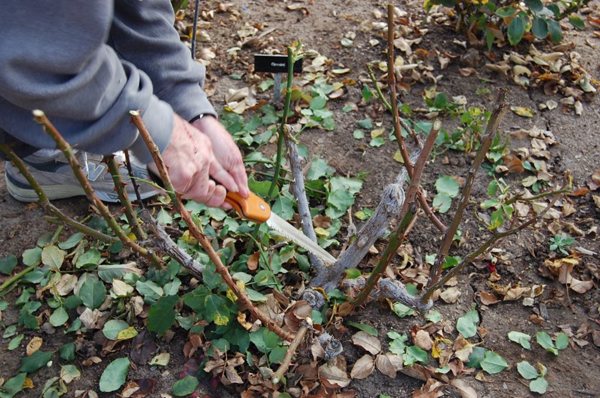

Hybrid tea roses are most popular with gardeners. From their ancestors, they got resistance to temperature extremes and the ability to form large buds of very different colors. Many varieties are convenient for cutting, as they give a single large flower at the end of the shoot.
Hybrid tea roses bloom from mid-June to early October. Autumn pruning of these varieties should be low to medium. Shoots can be shortened by half. Hybrid tea roses do not tolerate wintering very well and they need a margin along the length of the stems. If the upper part of the shoots freezes or is damaged by a disease, they are additionally shortened in the spring.
Climbing
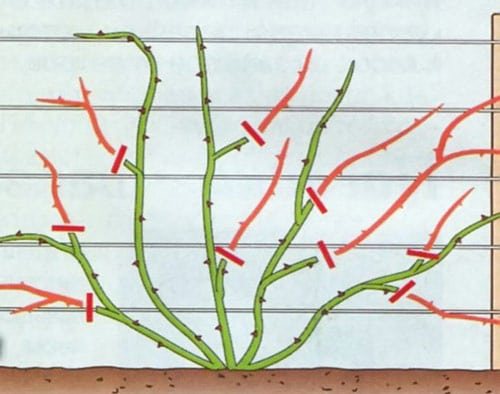

Climbing roses grown in Russia are of two types. They are subdivided into ramblers (curly look) and clamber (profusely blooming large-flowered roses with good winter hardiness). Each of these varieties has a different pruning method. The scheme for shortening shoots also depends on their number and length.
Large-flowered varieties form the bulk of flower buds on the crown of the shoots; when they are cut off, the third part of all lashes is cut off. Each branch should have no more than 10 buds. In climbing roses, only old and diseased shoots are cut.
How to cut climbing roses: video
Groundcover
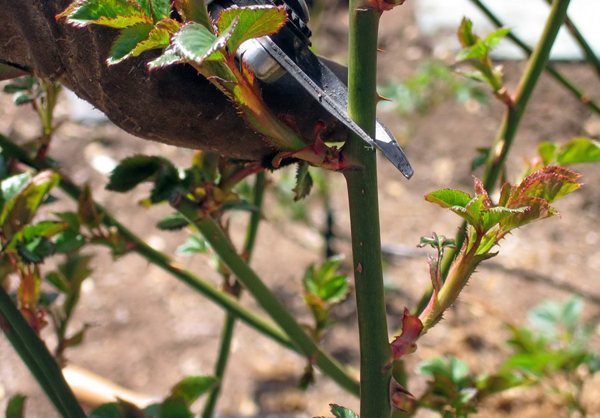

Many gardeners grow ground cover roses without pruning. However, this technique helps to maintain a harmonious bush shape and has a positive effect on the quality of flowering, so you shouldn't give it up. In autumn, at the end of the first growing season, all flowering shoots are cut out from these roses, leaving only the young shoots that have grown in the current year. In this case, diseased and weak branches are cut off completely, and healthy ones are shortened. Lateral shoots are pruned to a height of 10-15 cm from the base.
In the second year, the flowering lateral lashes, pinned to the ground, are removed, and the shoots of this year take their place. They are carefully killed in the ground and pinned. After that, the fixed branches are shortened by 2-3 buds. All subsequent years do the same.
Floribundu
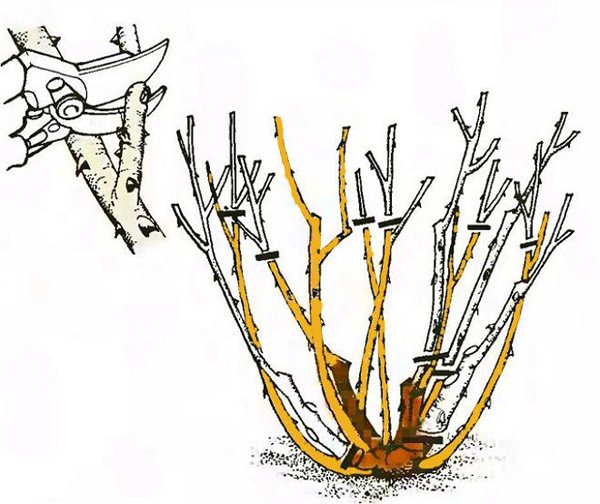

Floribunda roses are more powerful plants than hybrid tea and remontant varieties. Correct pruning is very important for them. Pruning the shoots too much can weaken the plant so much that it will stop blooming for several years. But even a weak pruning of this rose will not do her good. After it, the growth will be so weak that it will not be able to survive in the winter.
Formative pruning of roses of this group is carried out in the spring and should be combined. Old shoots need to be drastically shortened, and young ones only slightly. In summer, it is recommended to pinch the tops of the shoots in floribunda, and in the fall after flowering, to cut out all non-flowering and immature shoots.
Park
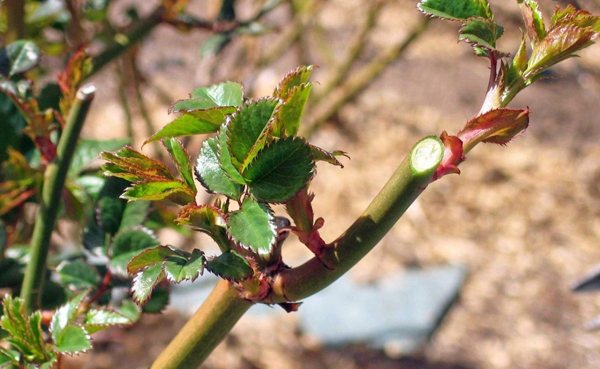

According to experienced flower growers, strong autumn pruning is not good for park roses. For the period remaining until winter, nutrients are redistributed from the shoots to the root system of the plant, which will make it possible to obtain abundant high-quality flowering in the next season.
An exception is made only for immature shoots, which are easily distinguishable by their appearance. These twigs are too soft and reddish in color. In spring, before the buds awaken, sanitary and formative pruning is carried out, lateral faded branches are cut off, and the young growth is shortened by 1/3.
How to cut roses for the winter: video
Pruning roses depending on the type
The structural features of a bush of different types of roses also dictate the rules for pruning.
Hybrid tea, floribunda
Plants belong to the group of spray roses, forming bushes up to 100 cm in height. Perennial is characterized by unpretentiousness, rapid growth and formation of flowers on the shoots of the last year.
Autumn pruning of a rose bush consists of:
- in shortening the shoots by half;
- removing old branches;
- short pruning (up to 2 buds) of weak branches.
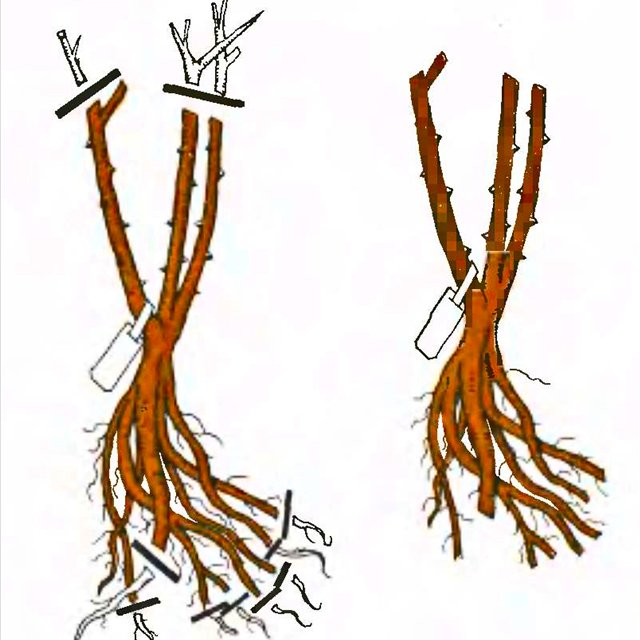

Slightly shorten the stems and long roots before planting
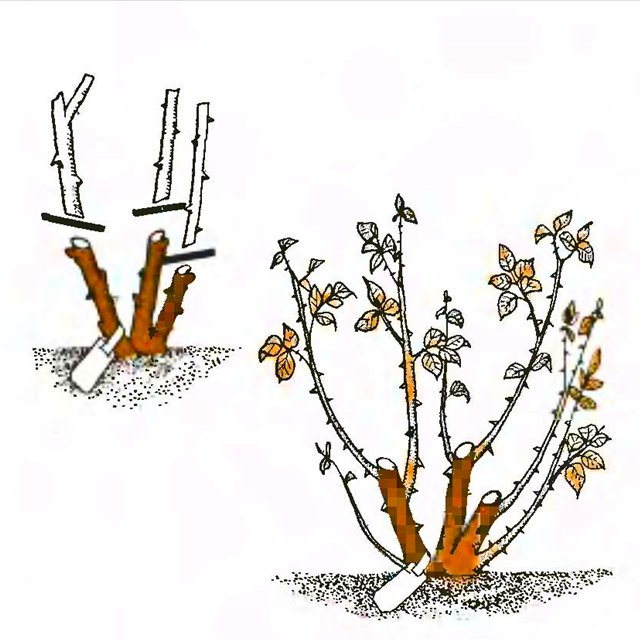

Autumn 1 year - remove non-lignified shoots
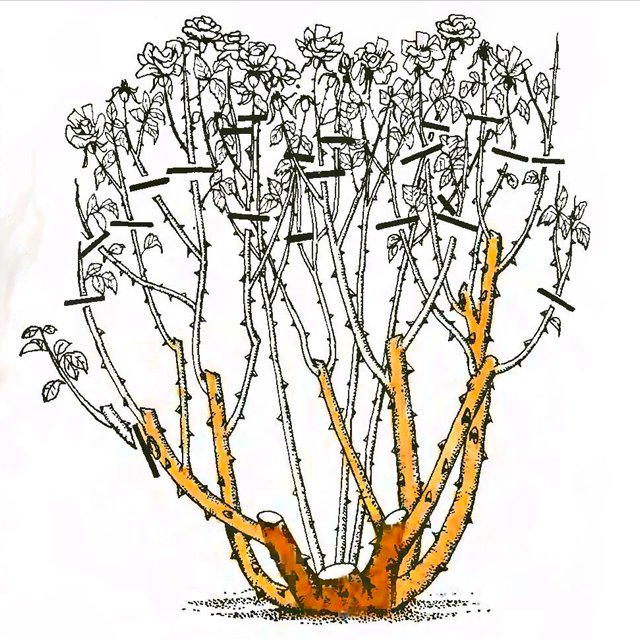

2 years and beyond. Faded and non-lignified stems are removed.
Park, miniature, polyanthus
This group of plants does not need to be shortened in the fall. Only the removal of damaged branches is carried out, the preserved unopened buds and dried flowers are pinched.
Climbing
These roses, like park roses, do not need to be shortened in autumn. Plants need only sanitary pruning and removal of faded buds.
Long shoots of a climbing rose are removed from the support and laid on the ground, placing boards on the soil. The plant is covered with agrotextile, wood shavings.
Groundcover, creeping
Roses that are placed on the surface of the earth or on horizontal structures (arches, trellises). Pruning this group of plants has its own characteristics.
How to prune roses in the fall:
- On a young plant in the fall, remove all the stems on which branches with flowers were located. Only young shoots are left, shortening them to 15-17 cm. The main stems are pinned to the ground.
- The next fall, after the previous short pruning, half of the two-year-old shoots are removed. The remaining stems are only freed from faded buds. Young stems are thinned out, leaving the strongest and evenly spaced.
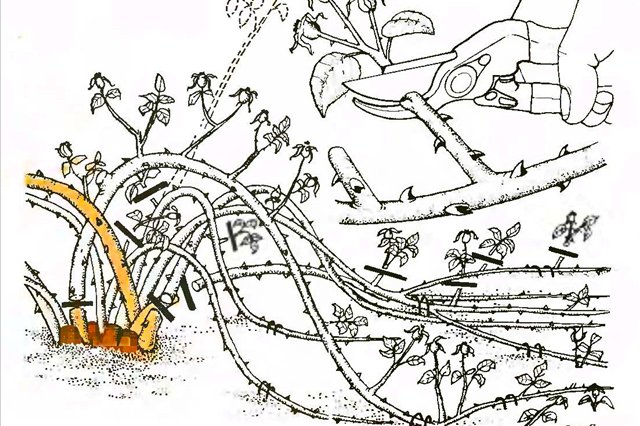

- Further, the formed crown of the bush is only supported. Remove old, diseased and thickening branches.
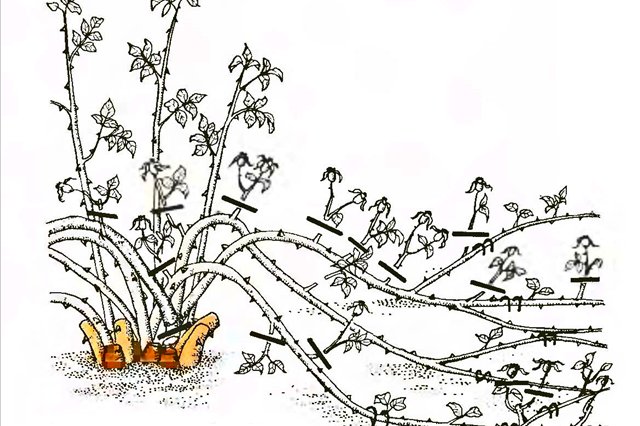

Illustrated by Brickell. To "Pruning plants"
English
Bushes of English roses do not require special shaping. It is enough to carry out a standard sanitary haircut, and remove shoots older than 3 years.
Stamp
Capricious in growing and caring for a rose requires a careful attitude towards itself. In autumn, the plant needs to remove unnecessary and weak branches, as well as wild growth, if such begins to grow from the rootstock.
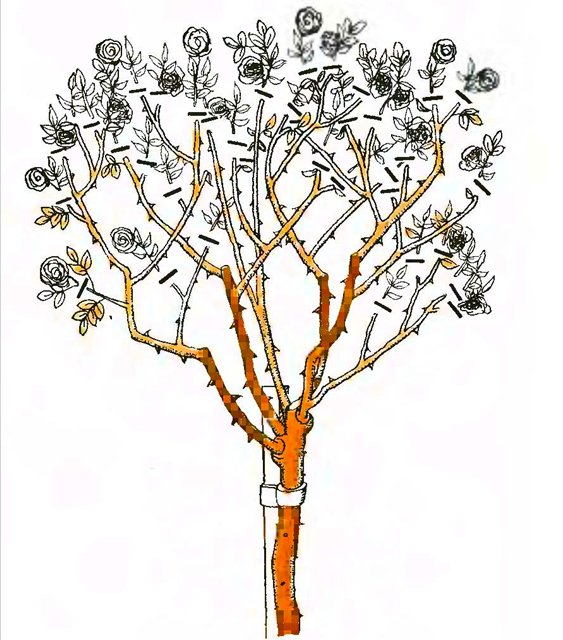

In the Russian climate, a standard rose has to be bent to the surface of the earth and covered with insulating materials in order to preserve it in winter.
Care after pruning


After the pruning is done, the sections must be covered with wood ash so that pathogenic microorganisms do not penetrate into the shoots. In 2 weeks, when the plants come to their senses, it will be necessary to carry out the last feeding in the current season, because during the flowering, the roses gave a lot of energy and they need to replenish the supply of nutrients. During this period, plants need phosphorus and potassium, but nitrogen is contraindicated.The granules are scattered under the root of each bush.
There is no need to water the roses, the last watering is done at the end of September. The lack of moisture is designed to reduce the activity of biological processes occurring in the plant. The shrub will begin to hibernate smoothly and prepare for wintering. In a rainy autumn, it is recommended to build a special shelter for roses from excess moisture. Above the bushes, you will need to stretch the film, and make small grooves around them for the outflow of water.
It is recommended to clean the soil around the roses regularly so that fallen leaves and plant debris do not infect the stems and root system of the plant with any disease.
When to stop with fertilizing roses in the suburbs?
The better you feed your roses, the better they overwinter - weakened plants find it difficult to survive in harsh conditions. But it's important to stop on time!
The last feeding with organic matter (compost or humus) should be done in early August. If later, new shoots will begin to grow, which will not have time to mature before the end of the season and will definitely not overwinter. But at the same time they will take away the strength of the plant. By the way, it is often advised to apply nitrogen fertilizers no later than July 15, but this again depends on the region. In the middle lane, a prolonged warm autumn often happens, so the beginning of August is the optimal time.
2 weeks after applying organic matter, feed the roses with phosphorus-potassium fertilizers. And a week later - potassium sulfate.
In early September, roses are given the last subcortex - kalimagnesia. That's all.
Together with the last dressing, the last watering is done.
Preparing for shelter
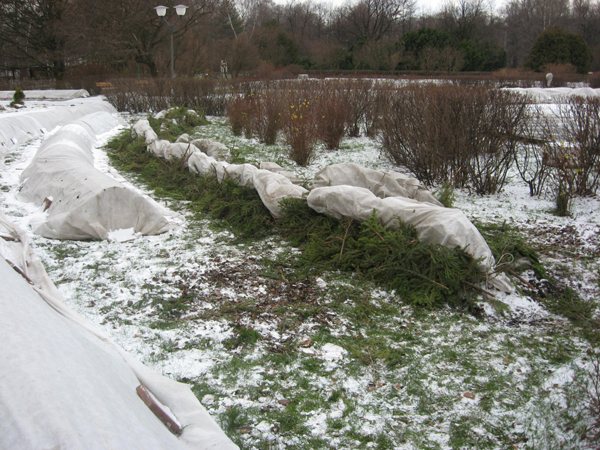

Before proceeding to the shelter, rose bushes are treated with a fungicide or iron vitriol as a preventive measure, and then spud to a height of 30 cm to protect the roots from the cold. Now you can build a shelter for wintering. The colder the growing region, the more reliably the rose should be covered.
Any breathable material, spruce branches, dry leaves are suitable as a shelter. To cover miniature roses, some use special wicker domes. You can use the bulk, frame, air method. In Siberia and the Urals, lutrasil is thrown over the main shelter.
Pruning and covering roses for the winter: video
As you can see, you cannot do without pruning roses if you want to get a beautiful, well-groomed, abundantly flowering plant. This procedure will not take long, but it will give you the opportunity to be proud of your magnificent roses and demonstrate them as your achievement in the gardening business.
Storing rose cuttings until spring
Pruning healthy rose shoots can be used for propagation. In this way, you can get planting material from the Floribunda rose, climbing and miniature varieties.
Twigs 12 cm long and with 3 buds are suitable as cuttings for planting. Save cuttings:
- in sphagnum moss treated with hot steam or a solution of any fungicide;
- in sawdust scalded with boiling water.
The material is poured into a dense plastic bag. The twigs are immersed in moss or sawdust so that they do not come into contact with each other. The material is lightly sprayed with water, the bag is tied. Cuttings are removed in the refrigerator, in the vegetable compartment or in the cellar. Sprigs of roses are preserved at a temperature of +4 .. + 6 degrees.
Today we examined the rules for pruning roses in the fall for beginners, as well as the features of the procedure for different types of roses. We hope you find this information useful.
The main principles of pruning
Only to those who are too lazy to read the recommendations for caring for roses, they seem capricious and painful flowers. They need care, like other garden plants, but it is not as difficult as inexperienced summer residents think.
People who planted flowers and trees on the site probably already have tools for caring for them.Manuals, magazines and tips from gardeners presented on the Internet will help you to properly prepare for the procedure for pruning plants in the autumn season. On television, programs are often shown dedicated to work on the personal plot.
Circumcision tools
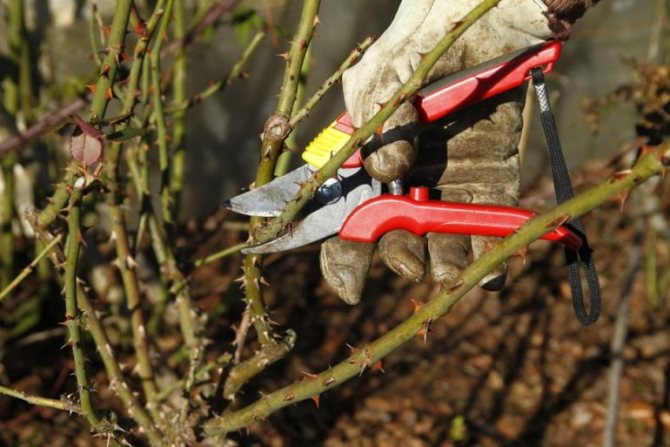

A set of rose pruning tools can be purchased at your local hardware store or gardening department. They are often sold in greenhouses along with rose seedlings. There you will also be able to consult with specialists and choose the most suitable tools.
Typically, rose care requires:
- garden knife;
- scissors;
- garden hacksaw;
- secateurs;
- brush cutter.
All tools should be sharpened to effortlessly prune rose bushes. The first two are intended for processing young and thin shoots, and the latter are used to cut woody branches.
The pruner will handle branches up to 2.5 cm in diameter. The hedge trimmer is a large pruner. They can shorten the thickest shoots due to the long handles. They need to be held with both hands.
The main convenience of a hedge trimmer when caring for roses is the ability to avoid pricks from thorns. The blades of the tool will reach the most distant branches, and at the same time it will be possible to keep your hands at some distance from the bush.
All garden tools usually have brightly colored, non-slip handles. This makes them easier to find and use in green grass.
Preparing for the procedure
At the end of September, rose bushes are watered less often to slow down the growth of young shoots. It is also important to stop active flowering. This is achieved by pinching new buds. Before the winter colds, plants will need phosphorus-potassium fertilizers in order to accumulate more nutrients in the branches.
Before you start pruning the bushes, all the tools that you plan to use should be disinfected in a solution of potassium permanganate. Thus, it will be possible to avoid contamination of plants with microbes.
After carefully examining the branches and assessing the size of the rhizome, you need to try to calculate the scale of the reduction in the volume of the bush. If the top and bottom are approximately equal, the rose will more easily endure wintering and will meet a warm season full of strength.
Slicing rules
Before starting work, it is worthwhile to study the instructions several times in order to understand how to properly prune roses for the winter. For example, the sawn-off cut must be done at an angle so that moisture does not accumulate in it. Immediately after the procedure, the place where the shoot is cut should be treated with Ranet or a special varnish-balsam.
The gardener must take into account that the new shoot will go in the direction where the bud is looking, above which the branch is obeyed. True, this is more important in spring pruning, when a bush is formed.
Spraying and hilling bushes
Each climbing bush needs regular spraying with special pest preparations. Rose is a very vulnerable crop that is susceptible to all kinds of diseases and can become an attractive environment for the development of dangerous diseases.
To avoid contamination, high quality antifungal and antiviral agents should be used. The old grandfather's methods in the form of a tobacco solution are powerless here. Better to give preference to the following options:
- inkstone;
- bordeaux liquid.
Important!
When performing the procedure, it is important not to spare the liquid and thoroughly rinse the stems, branches and even the soil composition.
The next step in caring for rose bushes is hilling. After successfully pruning, feeding and spraying the plant, you can begin to huddle it, loosening the soil at this time. This action will provide an effective passage of air due to the absence of weeds, and also protect the rose from the effects of cold weather.
Peat, humus or dry foliage is poured on top of the soil. It is important to make sure that it is really dry, because in a humid environment, dangerous viruses, fungi and parasites can develop.It is better to perform hilling in dry, calm weather. Any moisture will lead to irreversible consequences.
Advice!
If there is no desire to carry out short pruning, tall stems will have to be bent. At this stage, you should be extremely careful, otherwise you can damage the shoots. To avoid this, they need to be laid on the ground, and then bent down in arcs.
Pruning technique
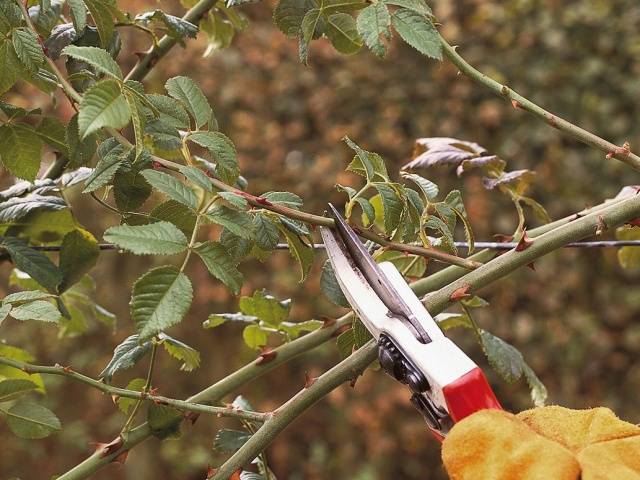

Only the first few bushes are difficult to cut. Having acquired a minimal skill, even novice gardeners successfully cope with this operation. Usually 3-5 strong, well-ripened shoots are left on a rose bush. But in any case, before you start pruning, study the characteristics of the variety. For example, more branches are usually left on scrubs.
Autumn pruning dates
Autumn pruning of rose bushes is part of the preparation for winter and is carried out just before their shelter. Wait for cold weather to set, and at night the temperature drops below zero. Any pruning of roses in the fall, carried out in a warm season, stimulates the development of the buds. If a thaw comes, they will start to grow, the plant will suffer.
The exception is multi-flowered climbing varieties. They are pruned in late summer or autumn, when bud formation is over and the wood is ripe.
Important! Do not forget that these roses form buds on last year's shoots, if you cut them out completely, they will not bloom next summer.
Choose a sunny, windless day and start pruning.
Pruning in the traditional way
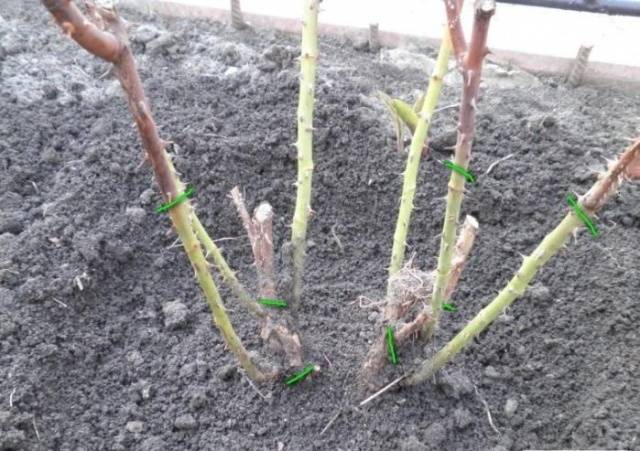

Pruning roses in the fall for novice gardeners is best done in the old tried and tested way. It can be used for all types of spray and standard roses. Let's take a look at a simple and understandable diagram in detail. Trim:
- all dead shoots to the ground;
- damaged, diseased branches to healthy wood;
- completely - root growth;
- thin and thickening stems;
- all unripe shoots.
As a result, only strong, well-ripened healthy shoots will remain on the rosebush. Further, it remains only to shorten them in one of the ways indicated below.
Strong pruning
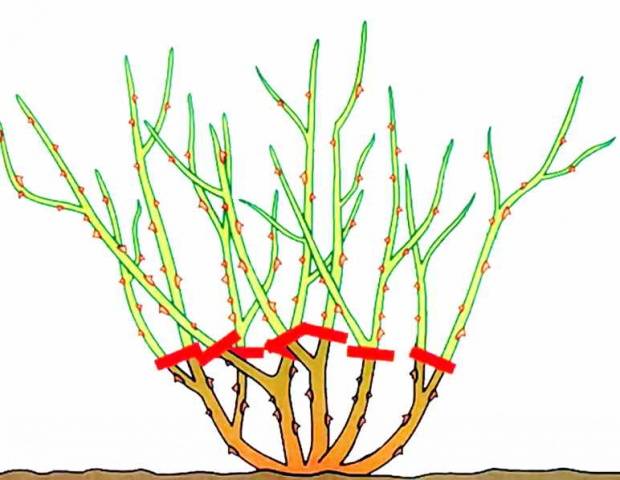

The stems are shortened by 3-4 buds, leaving about 15 cm. Thus, all newly planted roses and hybrid tea varieties intended for participation in exhibitions or for obtaining large buds are cut off.
This method is absolutely not suitable for rooted climbing roses, floribundas, scrubs. Strong pruning is not suitable for hybrid tea and park roses intended for garden decoration, except for rejuvenation or healing weakened bushes.
Moderate pruning
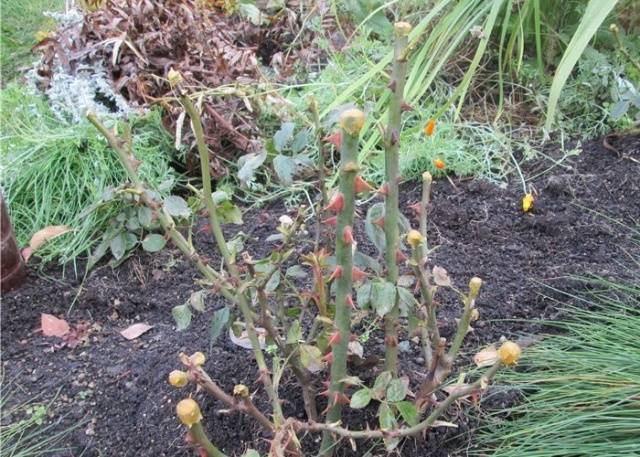

Strong shoots are shortened by half, weakened ones - a little more. Moderate pruning is good for all bush varieties. In floribunda roses, the old stems are shortened completely, and the annuals are only slightly pinched. Such pruning gives the bush a particularly attractive appearance and promotes long flowering.
Easy pruning
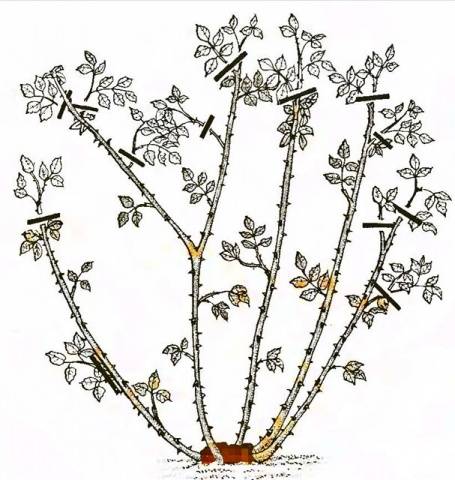

Shoots are only slightly shortened, leaving about two-thirds. So, roses will bloom earlier. Most varieties cannot be lightly pruned for several years in a row, as they stretch out and produce few buds.
Important! For roses growing in conditions of strong air pollution, only light pruning is used.
Pruning climbing and ground cover varieties
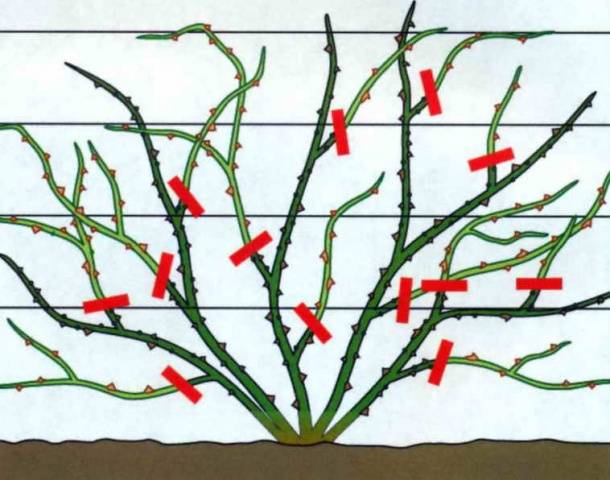

These flowers are not cut off at all, old, diseased, unripe and dried shoots are removed from them. In multi-flowered climbing roses, the lateral shoots are shortened by two-thirds, and the old skeletal ones - by a strong branch.
These are easy ways to prune roses for the winter. The video will help consolidate the knowledge gained:
Pruning tools
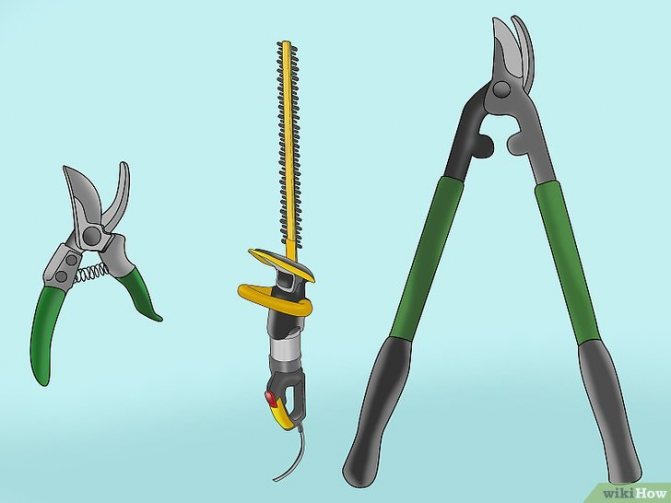

You can use the following tools for trimming:
- garden shears (they are convenient to use for pruning tall and climbing roses);
- a garden saw (it is used to cut shoots from 2 cm thick);
- secateurs (great for cutting thin shoots).
Important! All instruments must be disinfected.To do this, treat them with medical alcohol or a concentrated solution of potassium permanganate.
You will also need gloves, because cutting a prickly rose without them is very unpleasant and dangerous. It may be useful: a rug for knees or knee pads, a two-section ladder.
Autumn preparation stages
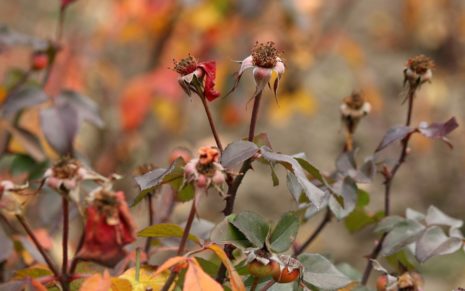

Caring for roses includes several stages. The first stage starts in September. The roses need to be dried, the trunks painted and the rose garden weeded. Getting rid of weeds is imperative, as is cutting the lower foliage to a height of 20 centimeters. So that pathogens do not harm the flowers, their bark is stained. For coloring, a special paint or copper chloride is suitable. Painting begins from the bottom to the hilling zone at a level of 30 centimeters. If there is a violation of the integrity of the leg, then you still need to paint the rose. Hilling of the variety occurs immediately after staining.
The putrid earth does not allow the bush to survive the winter safely, so the flowers need to dry the soil. For drying, a small greenhouse is created. On the frame arches, you need to throw a film that will create a kind of roof.
Loosening the soil, whether it is necessary to do it and why
Loosening benefits the bushes, making their color lush.
Loosening benefits:
- saturates the plant with carbon dioxide;
- improves soil structure;
- breaks small stones;
- gets rid of weeds;
- destroys pests.
It is necessary to loosen the soil after watering, when the soil has absorbed moisture. In the fall, the soil is loosened after pruning. In October - before the shelter of the culture for the winter. Surface loosening is carried out with a hoe-cat. A hoe is used for deep loosening.
How to feed roses in autumn
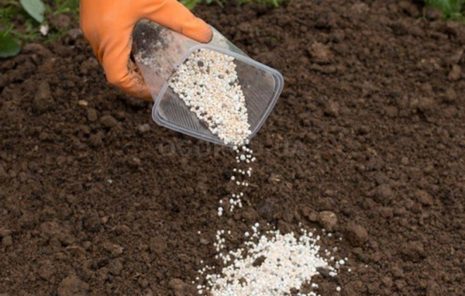

Watering the bushes at the end of August should be limited, and in September, stop altogether. If the autumn is rainy, then the bushes need to be protected by making special grooves to drain water and stretch the film. In October, after pruning, potash fertilizers are applied to the soil.
Top dressing is carried out:
- dry fertilizer;
- sub-root composition;
- liquid fertilizer for irrigation;
- liquid to spray the bottom of the bush.
Using fertilizers for irrigation, add 1 tablespoon of potassium sulfate, 1 tablespoon of phosphate and 0.5 teaspoon of boric acid to 10 liters of water. With this composition, the pink culture is fertilized 2 times, at the beginning and at the end of the first month of autumn. In the northern regions - in late summer and early autumn.
To prepare a spray composition, potassium monophosphate and potassium superphosphate are dissolved in 30 liters of water. Irrigation of the bushes occurs once a month until mid-October.
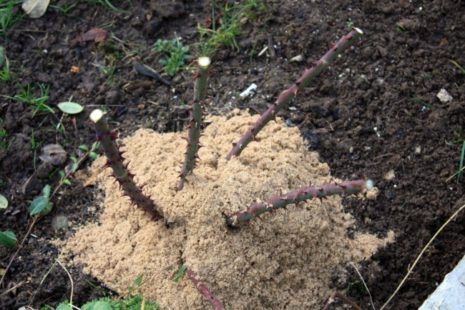

Wood ash, banana peel are used as dry top dressing.
Advice!
It is convenient to use a chemical composition in granules, scattered under the bush.
If the flower is small and stunted, then it is not cut off. To stop the growth, it is enough to pinch the bush. Spraying is another October procedure. For spraying use Bordeaux mixture. Rotting leaves and weeds, excess debris are removed from the site. It is necessary to remove the compost to stop the spread of pests that survive at low temperatures.
Removing excess foliage
This seemingly superfluous at first glance artificial measure, firstly, is determined by the need to prepare plants for a state of seasonal dormancy. Secondly, it is a sanitary measure against the appearance in the mass of not completely fallen leaves of a favorable environment for rot and the development of harmful microbes and fungi. Thirdly, in the autumn crown of the rose there are already many leaves damaged by black spot or other infections.
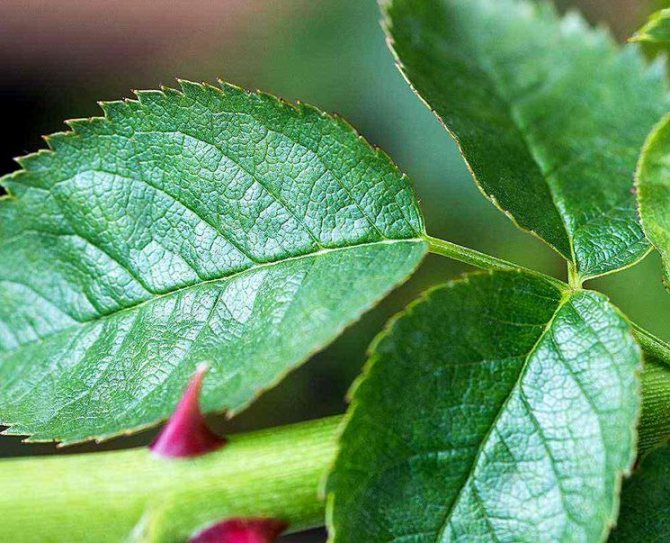

By cutting off excess and defective leaves, we prevent future seasonal problems associated with common rose diseases, and we make the process of wintering under cover safe and successful. Dispose of cut leaves by burning, giving no chance of spreading spores, microbes and viruses in the next season or significantly reducing their impact.
It's important to know! In no case should you pick off excess leaves, which leads to injury to future buds and shoots, but cut off with a clean and very sharp secateurs or scissors, for convenience, folding them into the trash can immediately. It is imperative to cut off underdeveloped inflorescences and fruits, thereby excluding their rotting under cover.
If you have several bushes, and among them are climbing or a whole rose garden, then such a preparation measure becomes too burdensome and almost impossible to do. It is important here to distribute forces and not to postpone the pruning of leaves for one pass, starting from September to do this sanitary pruning in a metered manner. If it is not possible to cut off all the leaves in full under the conditions of your rose garden, then you must first of all limit yourself to cutting out defective or diseased leaves. Spray those leaves that you do not have time to cut with Bordeaux liquid, copper or iron vitriol, as well as the Maxim fungicide. Treat the soil around the bushes with ash.
Important Tips
Preparing roses for winter in the Moscow region must be thorough.
So that the cold season does not bring grief, and the bushes come out by the spring rested and healthy, it is recommended:
- ventilate film shelters several times during the winter during thaws for air circulation and partial drying;
- when laying branches, it is imperative to construct a bedding of spruce branches, mulch, boards so that the stems do not touch the ground;
- preference is given to white material in order to avoid excessive heating in the spring;
- it is better to use 2-3 layers, where a film or other waterproof material serves as the outer;
- preparatory activities are carried out in full and on time.
How to cover climbing roses
Among climbing roses, there are 2 varieties:
- some easily fit under the shield shelter and are also quickly placed on the trellises in the spring;
- others are preferable not to touch because of the voluminous branches. But you will have to cover in any case, otherwise they will simply freeze out.
Material requirements and shelter times are the same as for standard varieties. For soft hardening, it is recommended to take your time and hold frost-resistant varieties at temperatures down to -5 ° in the open state. The greenhouse effect for wandering species is much worse than a slight frost. It leads to decay of the roots and premature awakening of the kidneys.
You should know: weaving varieties almost never shed their leaves on their own, they have to be manually removed in small batches, starting from the lower tier.
The choice of covering material is wide:
- the film transmits light, lasts only a year, retains moisture;
- spunbond is lightweight, easy to use, durable, unable to fully protect from frost;
- burlap has a low cost, is affordable, folds easily, gets wet, forms an ice layer;
- cardboard is perfect as an inner layer for a shield base;
- roofing material protects from cold and rodents, is used as a frame;
- coniferous spruce branches are economical, frightens off rodents, keeps a stable temperature, and gets wet.
Most often, a combined two-layer coating is used, which prevents the bushes from getting wet and freezing. If the branches can be removed from the frame, then they are laid under the shield shelter. If not, then a warm cocoon of 2-3 layers is built around the area. Insulation is placed inside, and a film is placed on top.
Pruning methods
Pruning is carried out in three ways. They depend on the length of the stem, the branching of the bush and the type:
- Short cut used for polyanthus and small-flowered species. During this pruning, 2-3 buds are left. It is rarely carried out, because there is a risk of freezing out the bush.
- Medium pruning, most often they use it. The bushes are cut to 35 cm from the ground level, 5-7 buds remain on the branch. It applies to all types of roses, with the exception of curly and ground cover roses.
- Long cut suitable when the buds are placed on top of the shoot.Roses are trimmed slightly or not at all. This pruning is suitable for large-flowered varieties.
Choose a medium cut if you have not defined the type of rose.
Be sure to remove:
- Old shoots (over 3 years old),
- White shoots, young branches (they will not tolerate frost and will become a place for the development of the disease),
- Shoots growing inward.
- Dried buds, flowers, leaves.
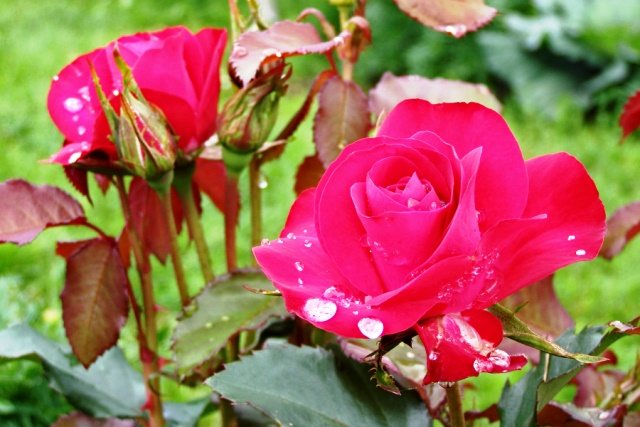

Climbing rose - pruning and bending
It is more appropriate to prune such varieties of roses in the spring. Weak and slender shoots should be cut shorter and strong ones half their length. Leave the most powerful and healthy ones without pruning. This will make it possible to form a cascading crown, in which in the summer the whole bush will bloom on new shoots completely, and not only its upper part.
When pruning a climbing rose in autumn, preparing it for winter shelter, the bulk of the shoots should be preserved, which will allow the bushes to maintain their vegetative strength by spring and quickly revive in a lush and blooming crown.
The process of work, and even more so bending down for the winter shelter of a climbing rose, is traumatic - they have large, often located thorns. For this reason, your equipment should be reliable from goggles to heavy gloves, especially all other clothing.
Trimming activities
The next key step in preparing a climbing rose for winter is pruning. When to cut such a crop, the florist decides, starting from the current weather and an approximate forecast for the next week. Not only the resistance of the crop to frost depends on trimming measures, but also its growth in the next season. In the absence of a procedure, the bushes simply cannot bloom in the spring or will be struck by the cold.
Correct pruning gives the plant good immunity, making it resistant to frost and disease. The principles of pruning are determined not only by climatic conditions, but also by varietal nuances. However, there are generally accepted rules that apply to all varieties of roses.
Already in mid-September (if we are talking about the middle lane, where the Moscow region is located), all foliage, which begins to fade, can be removed from the bushes. Such a procedure will prevent excess evaporation of valuable moisture, as well as protect the culture from leaf rotting under cover. In addition foliage can be a carrier of dangerous infections, which are problematic to find during visual inspection.
When the temperature drops to zero, rose bushes can be pruned. Tall specimens are trimmed first. A sharp pruner is used as a garden tool, which guarantees quick and painless removal of excess areas. Shoots are cut in such a way that 1 cm remains above the upper bud.
Helpful!
If you want to form a beautiful bush with vertical shoots, the bud should be left on the inside. If the task is to decorate a lush, spreading bush - on the outside. The cut point should look inward.
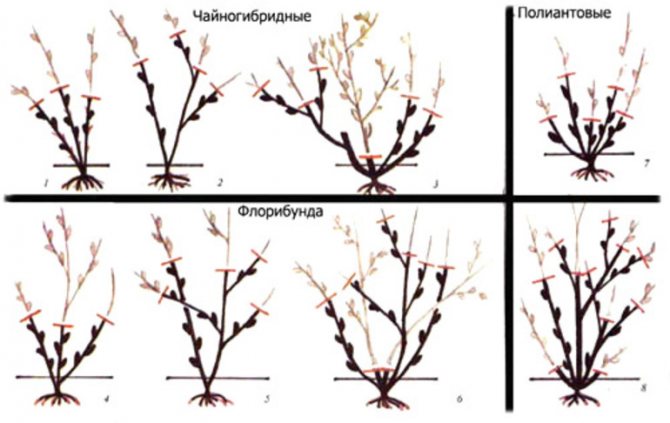

If the grower has mistakenly pruned the rose too much, this is not a cause for concern. The main task is to avoid damage to the roots., and flowering will be possible on new shoots, which will begin to form when the heat returns in spring. Moreover, deep pruning can be beneficial as it plays a rejuvenating role and is indispensable for those bushes that are starting to actively release new shoots.
Shelter subtleties
After successfully preparing rose bushes for wintering, you can move on to the next, and, perhaps, the most important stage - the shelter. Today, flower growers harbor culture in many ways, but the most relevant include:
- Digging in. After hilling the roots and placing a mulch layer on top of the soil, spruce branches or foliage can be put on top. With the arrival of precipitation in the form of snow, the rose will be well protected.Using this method, the main thing is to correctly calculate the timing, because if you cover the bush too early, it will get wet in the rain and begin to rot. But one of the main rules of shelter for the winter is to ensure maximum dryness. Also, some growers completely bury the flower, covering it with loose and dry soil.
- Dry shelter. Above the bush, a protective shelter made of plywood or pegs is arranged, to which the covering material is attached. Thus, a specific dome will appear over the bush, on top of which snow will soon appear.
- Cloth wrapping. Also, gardeners use a simpler method, wrapping the stems with a warm cloth, which not only acts as an insulating layer, but also prevents the roots from freezing. However, due to the mass of disadvantages, this method has not found wide application.
Advice!
When harboring a culture, it is important to take your time and do it too early. Humped bushes can easily endure 8-10-degree frosts.
Gardening Tips
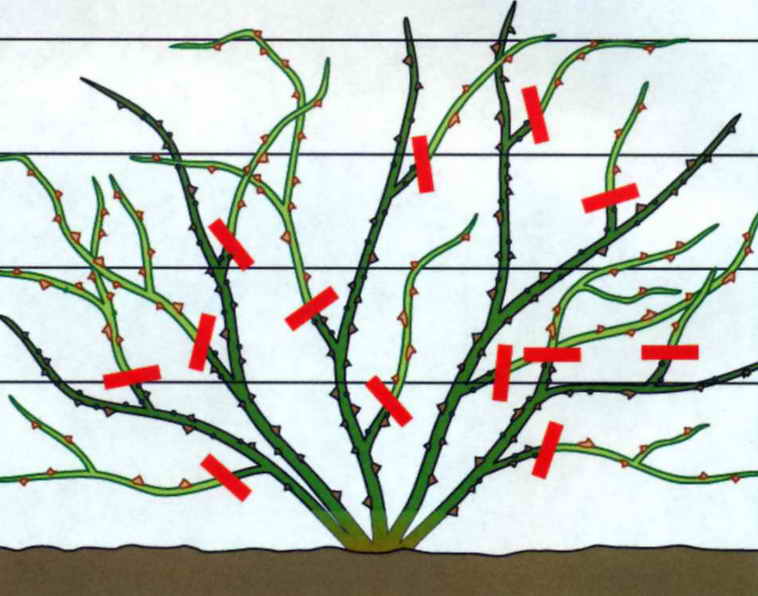

Using the color of the buds, you can determine the resistance of roses to cold weather. The most delicate and fragile flowers are yellow. White buds can withstand frosts down to -10 ° C, while red and burgundy buds can withstand lower temperatures. Given these characteristics of the plant, it is best to prune in late October or early November. After that, you can almost immediately cover them for the winter.
A clear and windless day is chosen for pruning.... You need to prepare:
- sharp secateurs;
- handy lopper or garden saw;
- thick gloves;
- garden rake;
- solution of copper sulfate.
Experts advise pruning not only old bushes, but also young seedlings. This will allow you to get juicy and strong buds in the new season. It is also necessary to take into account the points that will contribute to the strengthening and healing of the bushes.
Before pruning, you need to remove all inflorescences and be sure to pluck those buds that have not yet bloomed and ripened... It is recommended to cut off weak branches that have not had time to ripen, to get rid of the diseased growth.
Tools prepared for trimming must be disinfected with a solution of potassium permanganate. This will serve as protection against external infection of the bush. Pruning roses in the fall for beginners for the winter should be based on the principle: do everything in moderation. It is believed that the volume of the rhizome of the bush must correspond to its ground part, otherwise in the future such a plant will often get sick and quickly die due to lack of nutrients.
Pruning young and adult bushes: what's the difference
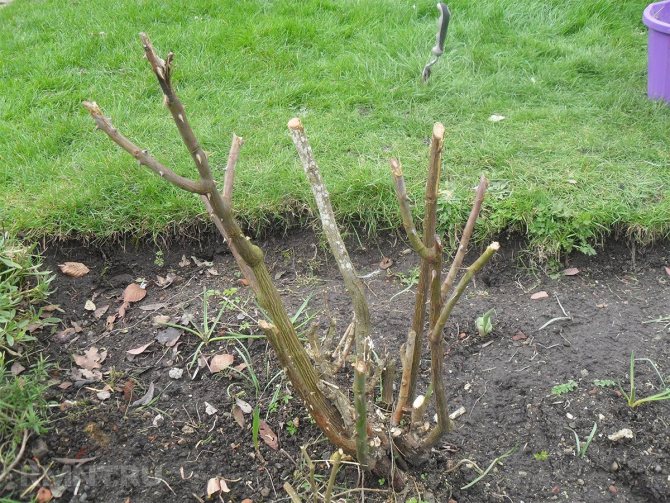

Some gardeners even resort to tool disinfection to protect plants from bacteria.
In rose bushes under the age of one year, the stems are cut to about half. The point of the procedure is to force the plant to use all reserves for root development, and not for foliage. A 2-year-old rose will have 2-3 regeneration branches on which flowers will grow. You cannot cut off these stems, the maximum allowable is to shorten by 2-3 buds in order to fully cover for the winter.
A lush bush can already be formed from a 3-year-old rose. To do this, the stems are cut at different levels, creating a beautiful neat hat.
Important points
When growing low-growing varieties, dry inflorescences are removed on the bushes and the highest shoots are slightly shortened. The optimal shortening length is 10-15 cm.
Often, shoots with buds are formed on park crops, which lend themselves to abundant flowering. It is not necessary to cut off such specimens, because the rose will begin to intensively grow new shoots. This principle applies to any early pruning that encourages the release of new lateral branches. It is better to cut off such parts of the bush after the formation of a stable cold.
Advice!
If new stems appear on the culture, they are simply pinched, preventing overgrowth. In this case, it will be possible to avoid the appearance of lateral shoots and late buds.
Pruning times in different regions
Pruning occurs at different times in different regions. Autumn in the Leningrad Region is famous for its rains and winds. To shorten the branches and remove excess shoots, choose a dry, clear day in mid-October. To get even and smooth cuts on bushes, you need a quality tool. Wounds are immediately treated with garden varnish or sprinkled with ashes. After a few weeks, the plants are covered with sawdust, peat, covering material.
In Siberia and the Urals, winters come quickly and are characterized by strong drops in temperature. Therefore, in these parts, the extreme conditions of roses grafted on a rose hip will better tolerate. A not too strong shortening of the shoots is carried out at the end of September and the rose bushes are covered after 2 weeks.
General principles
There is a large varietal variety of roses on sale, which allows you to create real flower arrangements on the site that will delight your eyes with their flowering until late autumn. The most popular are park, climbing, ground cover, floribunda and others.
Helpful! In home floriculture, it is customary to use climbing varieties, since they are an excellent solution for vertical gardening, are famous for their delightful decorative effect and are suitable for growing in the middle lane.
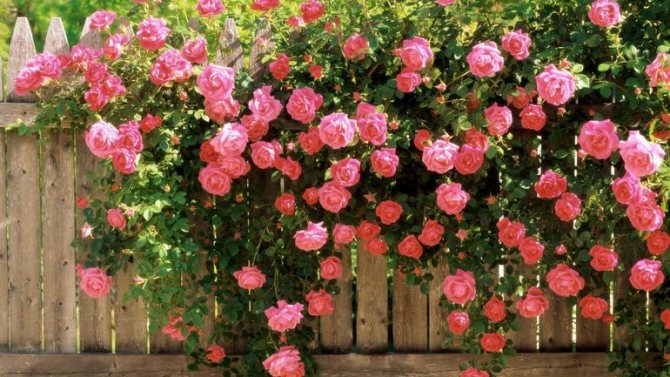

But like many other plants, roses need good shelter for the winter, especially if they are cultivated in the suburbs. After all, if flower growers from the southern regions can slightly cover the roots or leave the bushes on the street without additional insulation, then in the middle lane such a condition is mandatory. Otherwise, wintering roses in the Moscow region will be fatal. And even if the flowers manage to survive the winter under the thickness of the snow, with the arrival of the warm season, the frozen shoots will not be able to give abundant flowering.
How to properly bend climbing rose bushes
- Firstly, do not wait for a stable sub-zero air temperature, at which the rose twigs become fragile at a break without support.
- Secondly, for a gradual and gentle bending of the main branches, use a strong cord, which is tied with one end to the top of the branches, and the other end to the bottom of the trunk. Initially, pull it up to the possible bend of the branches without kinking, and then, even within one day, gradually shortening it by re-tying it.
- Thirdly, this process can be enhanced by boards laid on the bush, under the weight of which the branches of the rose can be bent to the angle of inclination we need.
Another thing is young bushes of climbing roses. It is enough to tie its shoots at a one-meter height with a rope and put them in a ring around the bush with their subsequent fixation, otherwise they will "disperse".
It's important to know! To avoid damage to the bent branches, they need to be tilted in the direction of the grafting site, as if "along the wool".
Bushes that are bent enough to continue the winter shelter process should be secured with arcs made of suitable material, or better with plastic flexible pipes that are frost-resistant, suitable for repeated use. Due to their flexibility, they can cover the entire protected bush of any size.


Optimal for growing and sheltering for the winter are special support grids, which can be hung on a wall or on a support post on special hooks. Such gratings make it possible in the fall to remove them together with the branches of the bush fixed on them and, with precautions against bending the skeletal branches, lay them down directly on the ground. First, put wooden boards or spruce branches on the soil so that the branches do not touch the ground.
It is important to know that roses of any type and variety, if possible, will be better bent to the ground, and not cut.
Rodent protection... Like all plants sheltered for the winter, roses are attacked by rodents, fleeing under cover from the cold, where they have a "table and a home."The right "treat" for them may be burdock thorns, blackroot root, but more reliable - waterproof poisoned bait "Cyclone"
When to start preparing for winter
Severe winters reign in the Moscow region. They are dangerous with a small amount of snow and sudden drops of the thermometer by a dozen degrees during the day. Since the beginning of October, summer residents have been on the alert, covering materials have already been prepared for crops that are most sensitive to temperature changes.
The desire to preserve the decoration of the garden until next year is understandable for any gardener, regardless of experience and experience. But without exact knowledge about the characteristics of the plant, it is difficult to do this. Roses have a lot of surprises for budding florists.
The paradox is that the flower tolerates frosts down to -10-12 ° C much easier than a long period of discussion under the covering material.
The optimal time for hiding roses is the end of October. There is still a remnant of heat from the soil, there is no deep freezing of the ground, so even short-term snow will not damage the stems and buds that have formed for the next year.

